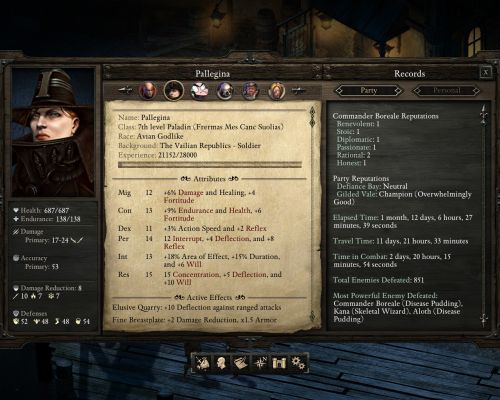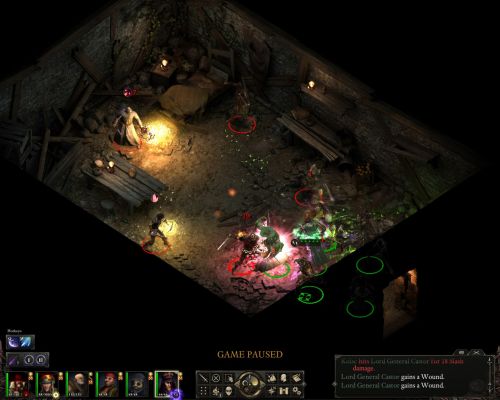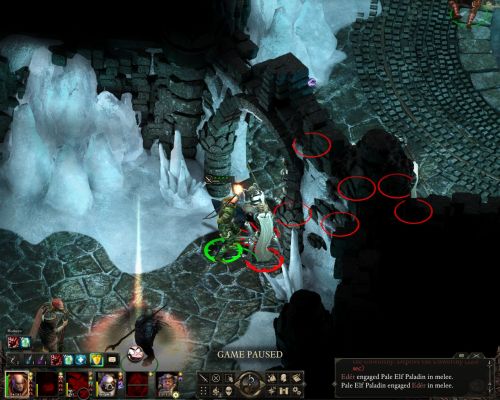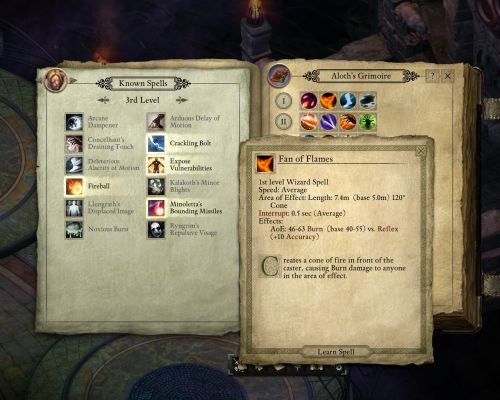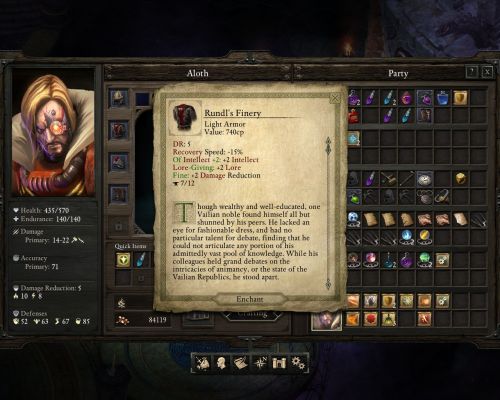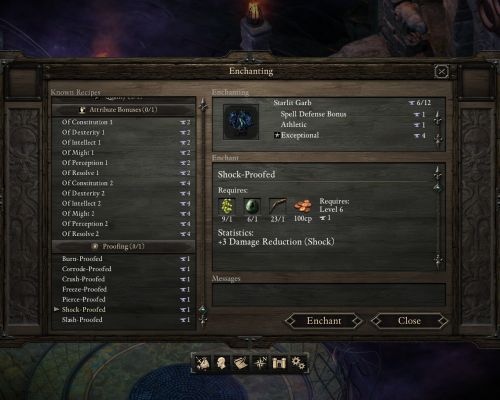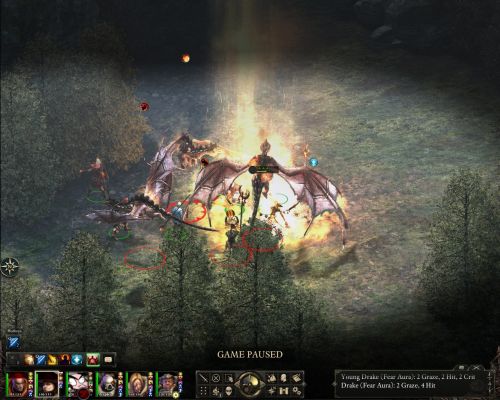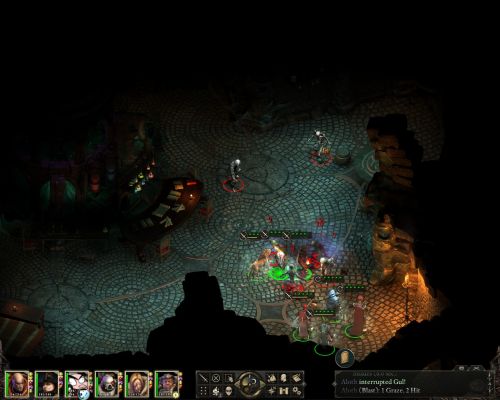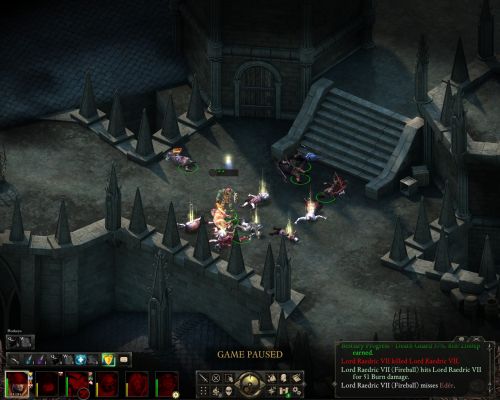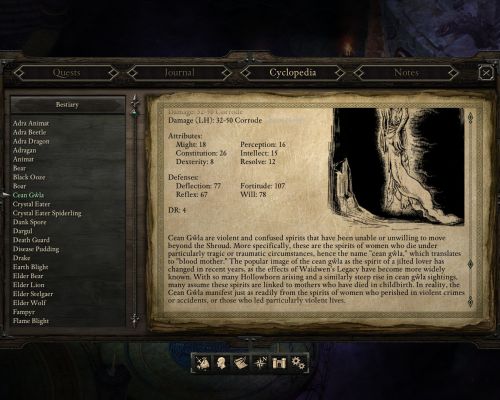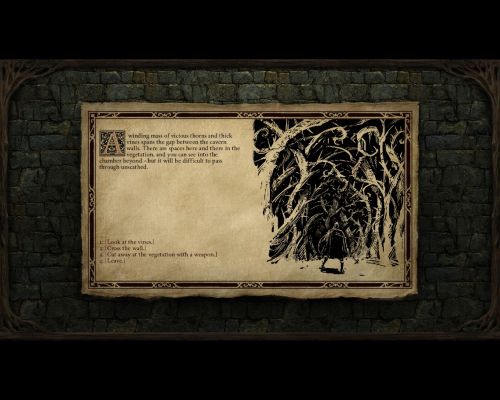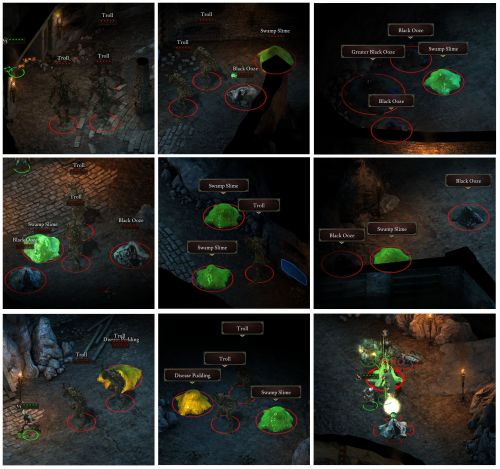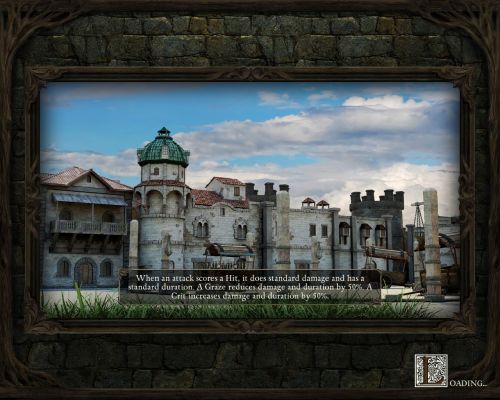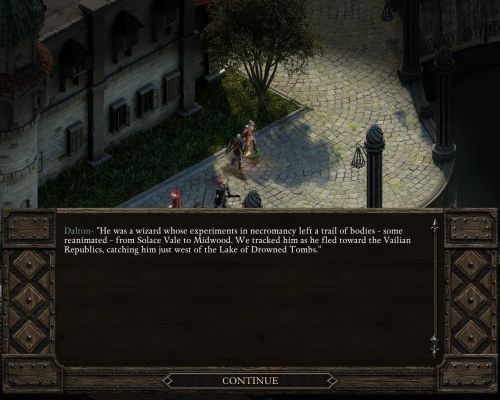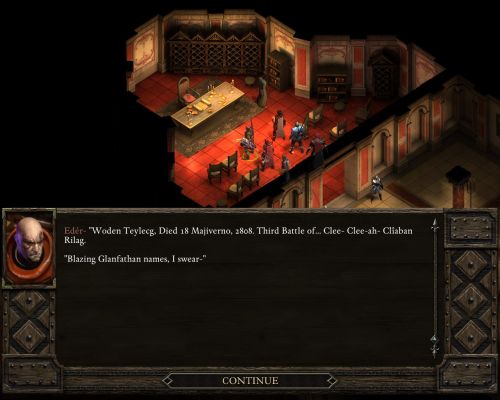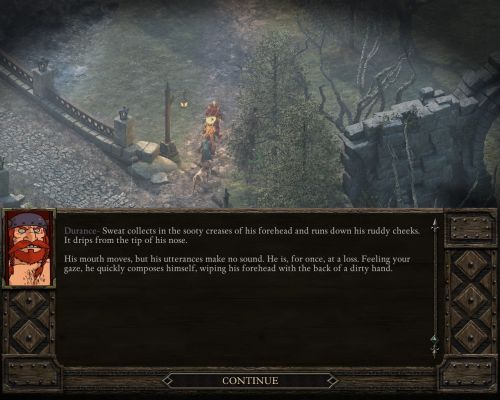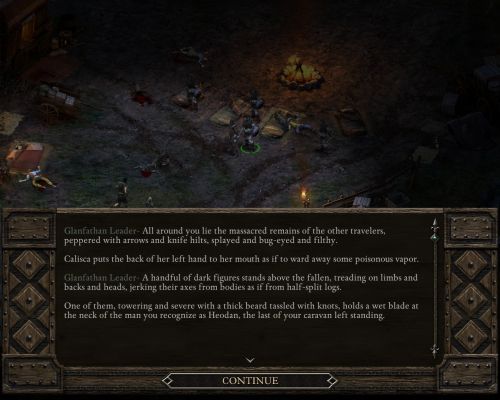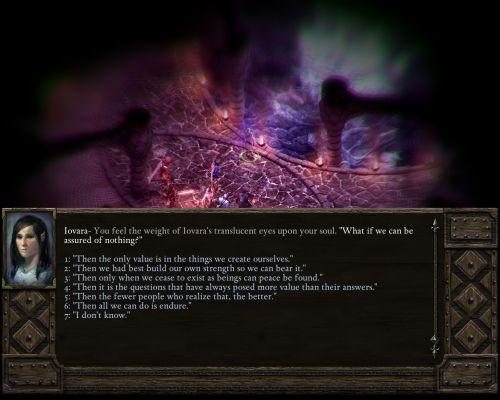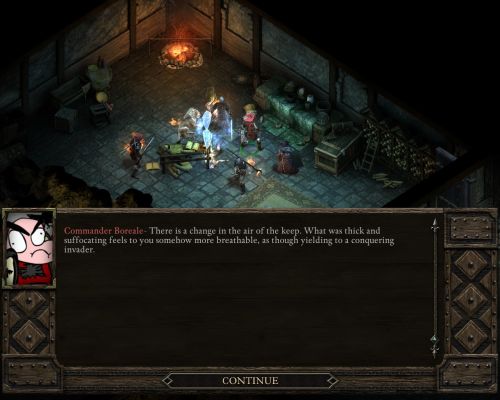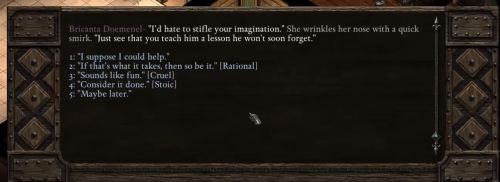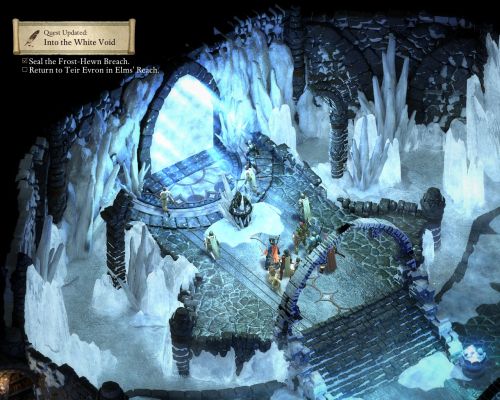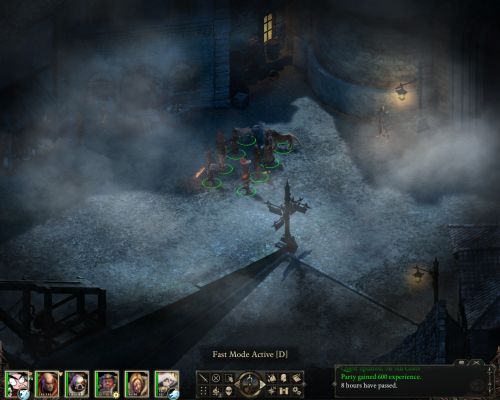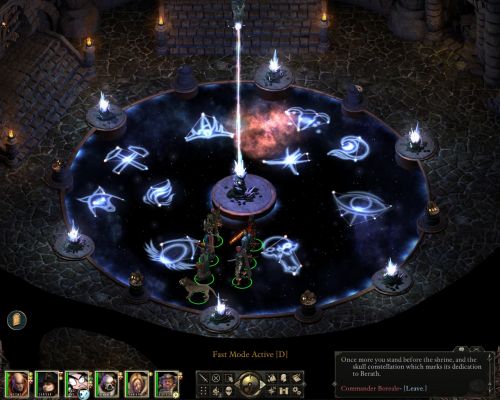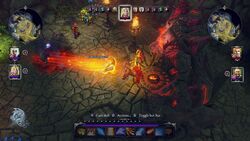RPG Codex Review: Darth Roxor on Disappointment, thy name is Pillars of Eternity
RPG Codex Review: Darth Roxor on Disappointment, thy name is Pillars of Eternity
Review - posted by DarkUnderlord on Tue 21 April 2015, 07:39:47
Tags: Darth Roxor; Obsidian Entertainment; Pillars of EternityDarth Roxor has written a number of reviews for us at the Codex. He's covered a whole range of games both old and new such as Shadowrun Returns, NWN 2: Storms of Zehir and Darklands among others (which I'd have put here but the search function is still on my list of things to fix). So what was his take on Obsidian Entertainment's first KickStarter project: Pillars of Eternity?
Despite the "hive mind consensus" that's often claimed, the Codex has always been about diversity of opinions. One of our founding tenets is that you are free to love or hate anything you want as long as you can explain why and back your opinion with arguments.
And Darth's opinion is that PoE is not good, just not good at all. Here's a bite:
I'll let you read the rest and judge for yourself.
Thanks to Darth Roxor for taking his time to review PoE for us, and stay tuned as we'll have some further perspectives on PoE before all is said and done.
Read the full article: RPG Codex Review: Darth Roxor on Disappointment, thy name is Pillars of Eternity
Despite the "hive mind consensus" that's often claimed, the Codex has always been about diversity of opinions. One of our founding tenets is that you are free to love or hate anything you want as long as you can explain why and back your opinion with arguments.
And Darth's opinion is that PoE is not good, just not good at all. Here's a bite:
When Obsidian Entertainment started their Kickstarter campaign for Pillars of Eternity in 2012 (under a working title of Project Eternity), many saw it as the second coming of Christ for cRPGs. There it was: the veteran developers from everyone’s beloved Black Isle Studios, reinforced by Tim Cain himself, wanted to bring us a modern successor to the Infinity Engine games. In their pitch, Obsidian described Eternity as something that would marry the combat of Icewind Dale, the narrative of Planescape: Torment and the exploration of Baldur’s Gate. Considering that a few years earlier Obsidian had given us the two Neverwinter Nights 2 expansions, Mask of the Betrayer and Storm of Zehir, that also fit parts of the above bill, it looked like there was no other choice but to get hyped.
[...]
Now, what do we make of PoE’s character system? Judged by its own merits, if I had to draw a comparison, I would call it the communism of character systems. Certainly, you have the feeling that everything you pick is kind of, sort of, equally useful (with some exceptions). But the flipside to this is that everything is also equally bland.
[...]
Your only reliable experience gains come from doing quests. That is certainly a reasonable approach by itself. It is however much less reasonable when you consider the amount of fighting you do in this game – all the trashmobs you steamroll through give you nothing, yet you are nevertheless forced to genocide them – most of this game’s playtime is spent fighting!
[...]
The bad encounter design and general lack of difficulty have one more very unfortunate result - they make exploring and dungeon-delving insanely boring. But make no mistake, this is also due to the dungeon design being very lacklustre to begin with.
[...]
Long story short, the stronghold has no use whatsoever. You can spend lots of money to fill it up with underlings and buildings, but nothing ever happens there. The buildings sell garbage. Your underlings don’t really do anything. Your free rest hall is behind 4 loading screens. You can even hold prisoners in a prison, and it has no effect on the game whatsoever. To say that the stronghold has been tacked on is the understatement of the century. Which is why I won’t even bother wasting more time talking about it.
[...]
The way the setting at large is presented to the player leaves a lot to be desired. PoE suffers a lot from its writers being obviously very proud of what they’ve done, so they make sure to tell you how awesome their setting is at every step – when an NPC starts talking about a distant place or a past event, brace yourself for a gigantic encyclopaedic infodump filled with dozens of alien names, regardless of whether the NPC is a commoner or a historian. This kind of exposition should be in the ‘cyclopedia’ section of the game’s journal, not in every second friggin’ dialogue.
[...]
Which brings us to what possibly surprised and disappointed me the most in PoE – the general writing quality is simply underwhelming. It never reaches any heights, it’s at best average and at worst abysmal. Everything is overly descriptive, very often just redundant and not leaving much for the player’s imagination. The majority of texts could easily be trimmed to one-third of their original size, which only tells me that PoE has never seen any editorial work apart from fishing out typos. One of the best examples I can think of is when you first meet Guy McBaddie the main villain, and the game makes sure to tell you at least three times that he is a bearded dude in a ceremonial robe and a fancy hat, even though the description is accompanied by two different illustrations in quick succession.
[...]
Now, what do we make of PoE’s character system? Judged by its own merits, if I had to draw a comparison, I would call it the communism of character systems. Certainly, you have the feeling that everything you pick is kind of, sort of, equally useful (with some exceptions). But the flipside to this is that everything is also equally bland.
[...]
Your only reliable experience gains come from doing quests. That is certainly a reasonable approach by itself. It is however much less reasonable when you consider the amount of fighting you do in this game – all the trashmobs you steamroll through give you nothing, yet you are nevertheless forced to genocide them – most of this game’s playtime is spent fighting!
[...]
The bad encounter design and general lack of difficulty have one more very unfortunate result - they make exploring and dungeon-delving insanely boring. But make no mistake, this is also due to the dungeon design being very lacklustre to begin with.
[...]
Long story short, the stronghold has no use whatsoever. You can spend lots of money to fill it up with underlings and buildings, but nothing ever happens there. The buildings sell garbage. Your underlings don’t really do anything. Your free rest hall is behind 4 loading screens. You can even hold prisoners in a prison, and it has no effect on the game whatsoever. To say that the stronghold has been tacked on is the understatement of the century. Which is why I won’t even bother wasting more time talking about it.
[...]
The way the setting at large is presented to the player leaves a lot to be desired. PoE suffers a lot from its writers being obviously very proud of what they’ve done, so they make sure to tell you how awesome their setting is at every step – when an NPC starts talking about a distant place or a past event, brace yourself for a gigantic encyclopaedic infodump filled with dozens of alien names, regardless of whether the NPC is a commoner or a historian. This kind of exposition should be in the ‘cyclopedia’ section of the game’s journal, not in every second friggin’ dialogue.
[...]
Which brings us to what possibly surprised and disappointed me the most in PoE – the general writing quality is simply underwhelming. It never reaches any heights, it’s at best average and at worst abysmal. Everything is overly descriptive, very often just redundant and not leaving much for the player’s imagination. The majority of texts could easily be trimmed to one-third of their original size, which only tells me that PoE has never seen any editorial work apart from fishing out typos. One of the best examples I can think of is when you first meet Guy McBaddie the main villain, and the game makes sure to tell you at least three times that he is a bearded dude in a ceremonial robe and a fancy hat, even though the description is accompanied by two different illustrations in quick succession.
I'll let you read the rest and judge for yourself.
Thanks to Darth Roxor for taking his time to review PoE for us, and stay tuned as we'll have some further perspectives on PoE before all is said and done.
Read the full article: RPG Codex Review: Darth Roxor on Disappointment, thy name is Pillars of Eternity
When Obsidian Entertainment started their Kickstarter campaign for Pillars of Eternity in 2012 (under a working title of Project Eternity), many saw it as the second coming of Christ for cRPGs. There it was: the veteran developers from everyone’s beloved Black Isle Studios, reinforced by Tim Cain himself, wanted to bring us a modern successor to the Infinity Engine games. In their pitch, Obsidian described Eternity as something that would marry the combat of Icewind Dale, the narrative of Planescape: Torment and the exploration of Baldur’s Gate. Considering that a few years earlier Obsidian had given us the two Neverwinter Nights 2 expansions, Mask of the Betrayer and Storm of Zehir, that also fit parts of the above bill, it looked like there was no other choice but to get hyped.
However, as some of my esteemed readers may know, I was sceptical of Eternity throughout its development. While my initial reaction to the Kickstarter was as euphoric as everyone else’s, the upcoming stream of updates explaining the game’s design philosophy convinced me that there was trouble afoot. Their content seemed to go directly against ideas that I simply found entertaining, both in regards to video games at large, and to cRPGs themselves. Not to mention the aspects at the core of what made the IE games fun. Nevertheless, I was certain that even if mechanically the game didn’t turn out well, it would still provide me with Obsidian’s trademark writing, quest design and reactivity.
But promises, hype machines and development processes are one thing, while the end results are another, which is why I shall not bother to delve into the former, and will just focus on the latter. I will attempt to judge Pillars of Eternity in regards to: the Infinity Engine games’ legacy, Obsidian’s earlier work in this field (mostly the NWN2 expansions), the developers’ experience in general and, finally, its value as a distinct game and new entry into the cRPG catalogue.
In the end, Pillars of Eternity’s (henceforth referred to as PoE) Kickstarter campaign gathered a total of over four million dollars. Let us see if this pile o’ cash was put to good use.
Mystic Knights of Eir Glanfath
The game abandons established settings and rulesets in favour of ones developed at home by Obsidian, whose one big purpose was to differentiate it from Dungeons and Dragons. The player’s first encounter with it will be during character generation.
In the beginning PoE allows you to generate only one character who will be the protagonist of the story, but later on you’ll be able to expand your party to a total of six members, either through the use of premade companions you find on the road or by hiring “adventurers” that are basically walking charsheets made by the player.
Character generation, as well as the whole character system, looks deceptively robust at first glance. There are six races with different attribute bonuses to choose from, and each one has at least two subraces (even if all three human ones are identical), there are eleven classes with different starting skills and statistics, six attributes that all seem to give something important, a ‘culture’ choice that also gives an attribute bonus and lastly a background that gives a skill boost. So far so good. Things get a little more ugly when we go further and put our choices under scrutiny.
Starting with races, you have your typical assortment of totally-not-DnD options. Humans, dwarves, elves, aumaua (aka not-orcs), orlans (not-halflings) and godlikes (not-aasimar), with all the archetypical racial bonuses you’d expect from them. Despite being suspiciously not-aasimar, godlikes are perhaps the only race here that is at least a bit original – they are children that have been ‘touched by divine sparks’, and thus have been born kind of superpowered, but also highly disfigured and shunned by society. Or at least that’s what the chargen will tell you because even if you pick a death godlike whose skin is black as tar, has no eyes and generally looks like a horseman of the apocalypse, nobody will really give a damn.
Classes are also a pretty standard roster, including all your typical wizards, monks and paladins (who are not actual paladins but ‘warriors with a conviction’), etc. Just about the only sort of interesting choice here is the cipher, who is basically a glorified psionicist anyway. They do have some interesting gimmicks to them, like barbarians doing area damage with all their attacks, or monk abilities feeding off damage taken (which you might find counter-intuitive due to their high defence), but they are hardly anything that majorly separates them from their most archetypical connotations. Still, classes have arguably the biggest influence on your characters’ future functionality, since they define a large part of the starting values and growth paradigms of your basic statistics – deflection, accuracy, health and endurance.
Defence (divided into four categories – deflection, will, reflex and fortitude, so in other words not-saving-throws) and accuracy are used in all to-hit rolls, so they are, as you may imagine, very important. The general formula for every attack success (and those are not just physical attacks, all spells also fall under this, no exceptions) is d100 + [attacker’s accuracy] – [defender’s defence]. Depending on the roll outcome, the hit can have 4 results – total miss (no effect, 0-15 on the roll), graze (half damage and half effect duration, 16-50), hit (full damage and duration, 51-100), crit (50% more damage and duration, 100+).
No less important are endurance and health. Endurance is the pool of a character’s ‘combat hit points’ – once enough damage is done to drop it to zero, a character is knocked out and will only rise after combat is over (and instantly regenerate all endurance to full). All damage against endurance also directly damages health – your long-term hp that is a multiplied endurance – and once that empties, the character dies. With no resurrections available in the game. Health can only be healed by resting or via two talents that are usable only once per rest – not even priestly heals can bring back lost health.
After picking a class, we move over to attributes – might, dexterity, constitution, perception, intellect and resolve. The big deal here is that supposedly none of them can be considered ‘dump’ stats – which you notice is flat out wrong after a few hours of gameplay. I’d say that the most important stat is might, since it influences all damage and healing done by the character, whether it is melee, ranged or spell damage (muscle wizards, ho). But even still, all things considered, the boost is underwhelming – roughly 25% bonus damage at ‘maxed’ might when you oscillate between 10-20 damage per hit? Wow! Nevertheless, it’s useful to prevent your character from just standing around picking its nose. Dexterity looks important at first because it gives you “action speed”, which governs the efficiency of actions (very useful for some mages and gunners) and the delay between them, but soon you realise that most of that is overshadowed by the armour recovery modifier anyway. Constitution looks important for frontliners because it gives a percentage boost to endurance, but the bonus is so miniscule, it’s trumped by per-level endurance gain anyway. Perception is probably the least useful of the bunch, as it affects a character’s interrupt rate – interrupts are coin toss rolls that can delay an interrupted character’s action slightly. Intellect is crucial for everything that casts spells because it influences the area of effect and effect duration of every ability. Last is resolve that can be considered an anti-perception, since it boosts concentration, your resistance to interrupts. All the attributes also give some minor adjustments to saving throws, and considering that each defence type is boosted by 2 different attributes, the system simply leads to a very disappointing feeling of “sameyness”, even among different attribute distributions.
Thus, when you inspect the attributes with this knowledge, it becomes very obvious what you can dump and not. Characters whose only duty is to facetank just need to pump con, per and res to bloat as many saving throws as possible. Casters can forego almost everything except might and int with a sprinkle of res. All assorted dedicated ranged fighters can just pump might and assign everything else completely at random, perhaps also investing in per. Interestingly enough, the most ‘balanced’ set of stats is necessary for melee characters focusing on damage, simply because they will have to forego some of the facetank’s stats in favour of might.
And now we arrive to one of the two parts of the system that simply kill it for me. After you are done with character generation, your input when it comes to raising accuracy and defences is extremely minimal. Your only sources are: buffs, items and talents. However, all of them are in some way unsatisfactory. The buffs you will hardly ever use, but I will elaborate on that later. Items, while decent for defences (even though they are limited by a ‘no stacking’ policy), are extremely limited when it comes to accuracy – apart from inherent basic weapon mods and going in shieldless, only a weapon’s quality can boost a character’s accuracy, and the best one (superb, +12) is rare as hell. Talents, on the other hand, have some really powerful no-brainer boosters, but the vast majority of them are class-exclusive, and most of these still are only available to the fighter. And while in the case of defences you can still somehow scrounge up the bonus points, it is simply infuriating how little influence the player has over his accuracy – as you may have noticed, none of the attributes affect it. Your biggest source of accuracy is class choice + bonus gained per level, which makes Pillars of Eternity fall into the same trap as Divinity: Original Sin – passive level gains simply trump everything. You level up, get no real choices during that level up, and suddenly your character becomes more beefy and deadly – in the end, a character’s accuracy reaches roughly 75, +/- 10, 50-60 of that being only from levels and starting values. Now combine that with the fact that getting ‘overleveled’ in relation to the challenges you are facing at a particular moment in the game is tremendously easy, and the problems just keep piling up.
Moving on, we have the final pieces that make up a character, which are skills and talents.
At first, skills look as deceptively interesting as the rest of the character system. There are five of them in total: athletics, lore, survival, mechanics and stealth. Their number and actual functionality are not particularly compelling – athletics postpones the fatigue penalties induced by not resting for longer periods of time, lore lets you use spell scrolls, survival boosts the duration of consumables, mechanics is there for all your traps and locks, and stealth boosts your scouting abilities. The sad fact of the matter, however, is that only two of these skills have any right to exist – at least 3-4 points of athletics are mandatory on every character if you don’t want them to start whining after 5 minutes of no camping, and it’s also necessary to make one character into a dedicated mechanics expert. There is hardly any reason at all to give stealth to anyone, while survival and lore turn out pretty worthless in the long run, but more on that later.
One might, however, be lured into thinking all those sweet skills will be a large benefit for the player character in dialogues. Their broad fields of use basically scream ‘hey, I’ll be important to let you drive dialogues and text adventures into cool territories!’, but this also turns out incredibly disappointing as the game progresses. Options that rely on skills and aren’t purely for flavour are so rare, you might as well disregard them completely. And even those that do have some effect are very rarely different than just avoiding combat with a trash mob.
When it comes to talents and special abilities, those are fairly underwhelming as well. A character gains one every few levels, and when you take a look at them, you simply can’t shake the feeling that, with only a few exceptions, you are simply picking an option that is the least useless, and not one that fits you the most. It is a bit less true for class abilities because those usually have one line of consecutively unlockable stacking bonuses that improve That One Thing You Keep Doing All The Time, while the other ones are kind of crap. Talents, though, now that’s an exercise in futility. These are divided into 4 categories – class-specific, offensive, defensive and utility. Except for the elemental damage boosters and some very crazy niche concepts, you can just about forget about utility talents. Defensive ones you’ll never pick if you aren’t a frontliner. Offensive have a few that you perhaps might find useful, and one no-brainer category to boost accuracy (weapon foci). Class talents obviously differ from character to character, but a few of the classes have unique talents so terrible, you’ll be left scratching your head thinking of any use for them. Ranger and its supply of animal companion talents that are all, without exception, completely worthless is an especially good example of that.
A big part of the character system that also needs addressing are the spell selections for various casters. By ‘casters’, I shall refer to druids, ciphers, wizards and priests.
Druids, wizards and priests are about as not-DnD as you can get. Just about every spell of theirs will give you deja vu of some sort, and they also retain the vancian spellcasting formula of ‘you can only cast x spells of y level before resting’. Except that they have also been “adapted” to PoE’s ruleset and design philosophies, and by that, I mean that many of them have simply become terribly boring, if not downright useless. The state of the buff and debuff spells I shall leave for the combat chapter, but if I had to shortly describe the spell schools for each of these classes, it would be roughly this: The druid is good at everything and overshadows all other casters, the priest would be good if buff spells didn’t suck and the endurance/health system wasn’t broken, and the wizard got terribly shafted.
The druid can heal, do damage, buff everyone, debuff, drop some crowd control and summon elementals, he’s also decent in a fight due to shapeshifting. Compare that to the priest that melts in any melee, whose damage spells are lacklustre, and who can drop a few buffs before standing in a corner and being useless.
Also compare that to the wizard who has roughly 1-2 spells per level that are either hilariously broken or which are the only useful spells to begin with for that level, and whose all buffs are self-targeted and have some clause attached to them that makes them terrible. It is perhaps the most criminal here just how boring the wizard is as a class. You can only memorise 4 spells for every level, but you will never have to juggle them or even do as much as to think which of those will suit you better, because, as said before, you will never use more than 1-2 from each level. What makes it even more bitter is that the wizards have one potentially cool mechanic – all the memorised spells have to be put into a wizard’s grimoire, and you can even carry around a few of those and change them in combat to ‘extend’ your spell selection. But you simply never have to bother.
Finally, we have the cipher, and oh boy is that a good one. The cipher has access to some of the most broken abilities in the game, it is not limited by spell memorisation, and its spellcasting resource not only regenerates to half after each fight, but is easy to refresh in combat as well. For all the pre-release talks of system balance meant to equalise all classes in PoE, the cipher stands as a proud testament to the contrary. I can only wonder who it was that looked at the final result that was this class, compared it to everything else and thought ‘yup, this is a good idea!’.
Before I close this chapter, I would also like to talk about itemisation, for a man without the clothes on his back is but a bare character sheet. The available basic weapons are actually decently varied when taken under closer scrutiny, differing in damage, weapon speed, interrupt rate, etc, but I wish I could say the same about armour types. PoE’s armour system is rather underwhelming simply because of how binary it is. The only statistics you will find here are raw damage reduction and the recovery rate penalty - the heavier the armour, the less damage you’ll take, but you’ll also wait longer between actions. Suffice to say, this just leads to your melee dudes stacking up on the heaviest armour they can get and facetanking while doing nothing, and your other dudes safely standing in the back naked to get the lowest action delay.
The game also drops the ball when it comes to magic items. None of the items you find, even the seemingly “legendary” ones, ever really feel “unique”. That’s because there aren’t really any “unique” effects to be had, everything is systemic and taken straight from an effect table of some sort. Think back and recall the Mace of Disruption in BG 2. Or the Axe of the Jester in PS:T. Or the Messenger of Sseth in IWD. Unique items that actually had unique capabilities not found anywhere else. This is simply not around in PoE.
And finally, crafting, which is not only barely even there, but is also uninspired to boot. There is only one unique item in the game that you can assemble from some parts you can find (and it’s not even that impressive, either), everything else is limited to just setting an item’s quality, giving it an elemental damage boost, an ‘of slaying [x]’ mod or an attribute bonus. I just don’t understand why Obsidian didn’t go for a crafting model similar to the one they did in, say, Kotor2. Sure, it mostly just boiled down to juggling mods on every item, but hey, at least finding a new component was always cool that way, and it left you with a room for lots of min-maxing.
Also, I think the most striking parallel that I can put here is that 15 years ago when you killed a dragon in Baldur’s Gate 2, you could take its scale and craft yourself a bitchin’ suit of armour that would outshine most other ones in the game. In PoE, you can use the scale to add yourself a +2 damage reduction to your generic plate mail...
Now, what do we make of PoE’s character system? Judged by its own merits, if I had to draw a comparison, I would call it the communism of character systems. Certainly, you have the feeling that everything you pick is kind of, sort of, equally useful (with some exceptions). But the flipside to this is that everything is also equally bland. The characters are samey. The playstyles for different parties hardly ever differ, unless you go for something crazy like 6 wizards. The statistics you pick hardly even matter as long as you have the levels to support them. It is simply weak, generic and uninteresting to boot, and it’s particularly funny just how much it feels like a neutered DnD.
But speaking of DnD, I suppose a question needs asking: how does this system compare to the IE games? Well, it definitely has more options than the early 2nd edition ones, like BGs and IWD1, but it simply can’t match Obsidian’s very own NWN2, or hell, maybe even IWD2. Not to mention that the character systems of the IE games were weak to begin with, and saying that PoE reaches higher than that is not exactly much of a praise.
How I learned to stop worrying and love the Bîaŵacs
I suspect most people who liked the IE games can agree with me that, save for PS:T, the best thing about them was the combat, or, more specifically, the general encounter design and dungeon-delving (devout rtwp detractors need not apply). Who doesn’t remember nuking the hell out of ghostly orcs and elves in the Hand of the Seldarine, or smacking down Firkraag, or the frequent wizard duels?
Well, the bad news is the designers of Pillars of Eternity apparently don’t remember them.
But first things first: PoE introduces a few very significant changes to the way combat is resolved compared to the IE games, and they need to be discussed to put every piece of the puzzle that is PoE’s Perilous Punchouts in its proper place.
The first is the engagement system, which is basically a glorified set-up for attacks of opportunity. Once a character attacks another one in melee, they become (emotionally) engaged – and they stay that way until one of them is killed or disabled. Of course, a character can break engagement and try to run for it, but in many cases this is not a very good idea, as it invokes an attack of opportunity – it’s an instant blow with bonus damage and accuracy that can be safely shrugged off only by lategame fighters. I can only guess what the reasons for including it were, but one thing is for certain – its addition only means trouble.
When it comes to reasons, I can think of four. One, the most likely, was to stop kiting in combat. If a squishy character gets engaged, it’s very much a goner, particularly because it’s just gonna keep swallowing AoOs and getting re-engaged. But a savvy player will very easily overcome that anyway. The second purpose could be to implement a comprehensive way of stopping the enemies from rushing towards your backline. Third, which is mostly an extension of the second, could be a band-aid solution for a need that has arisen due to PoE’s relative lack of hard crowd control and disables – in BG/IWD, if a dude broke through to hack up your mages, you could cast hold person and be done with him. In PoE, not so much. Fourth, which is just about the only one that kind of makes sense, is trying to contain the clusterfuck most fights would otherwise devolve into – the general game speed of PoE is much higher than that of the IE games.
The problems with engagement, however, are very, very numerous, and all of them have a negative impact on combat. For starters, there is no leeway whatsoever when it comes to movement while engaged, no equivalent of five-foot-step – your character does as much as move its foot and it eats a hit to the face. This punishes any sort of repositioning or manoeuvrability badly enough to turn every fight into the fantasy equivalent of trench warfare.
Secondly, engagement promotes (actually, enforces) gameplay styles known from cheap mmos, something that I’d much rather not have in my cRPGs. You need a “puller” character to get the attention of enemies (bonus points if you encounter one of the many mobs that are very badly linked and just approach you in subgroups), you need a “tank” to stand there and gather up “aggro”, and you need a bunch of “DPSers” to nuke everything. What is this, WoW? And coming back to trench warfare – I am of the firm belief that the “optimal” way of playing PoE is to have 1 superbeefy tank that can stand there and shrug off every blow headed its way, another “tanky dps” melee to aggro any stragglers, and 4 ranged characters that will tear everything to shreds with ranged volleys – for the record, you can also do the same with a primarily melee-oriented party, but the end result is mostly the same, just with more clicking and time wasted involved. Which is primarily enabled by the third big issue:
The enemy AI is completely retarded and can’t deal with engagement at all. You will never see enemies do anything clever. You will never get outsmarted in any way. After you get the attention of a mob, it will just go forward and crash against your shield wall without any consideration, even if it means dropping 6 dudes against your tank instead of rushing for your backline. There are only two enemy types in the whole game that ignore engagement one way or another, and one of them quickly becomes a pushover (shadows), while the other you can find in three places at best (fampyrs). All the other enemies don’t have any routines apart from ‘rush the closest dude I see!!’, and the precious few that have abilities of some sort only have it coded to use them against a party member with the lowest saving throws, which becomes very apparent when you see the same party member get struck by certain effects time after time after time while everyone else doesn’t get targeted even once. The AI also has a particularly funny habit of nuking itself with its own area spells and abilities.
Now consider these issues, play for a few hours, and you’ll suddenly get the revelation that you just keep doing the same shit all over again because that’s really the only way this game can be played, as enforced by its systems. You send a fat dude ahead, gather all the aggro, kill off the enemies that waste their time trying to hit the tank with a gazillion deflection, move on. Rinse and repeat for 40 hours straight.
Oh, and speaking of AI, the party member AI is hardly up to snuff either. One thing that plagues this game and certainly makes it the true IE successor is the terrible pathfinding all around. PCs will get stuck on other PCs instead of going around them, they will keep trying to run through walls, they will get stuck and not move an inch unless told to, the usual. But what definitely is the most infuriating is the work of some joker that programmed the AI routines for handling charmed and confused party members. You see, charmed/confused PCs are automatically marked as ‘hostile’. This means your dudes will return fire when attacked by them, switch target to them when done with their current target, and even use goddamn AoOs when they move close. Suffice to say, you are mostly best off disabling allied AI completely.
By far the worst part of PoE’s combat, however, is the encounter design. Or, more specifically, the lack thereof. The above problems with AI and engagement would have been considerably less prominent if the enemy encounters had ways of bypassing them. If, for example, the enemy could just delete your ‘tank’ outright from the equation, you’d be in trouble. But the game (almost) never does that. This is due to a couple of reasons.
For starters, the amount of trash combat in this game is simply astounding. I swear to God, and I wish that I was exaggerating, but in my view some 90% of this game’s combat encounters can be simply considered trash mobs. Most of them are shamelessly copypasted, boring as all hell, an absolute pushover to deal with and can appear many times consecutively in the same lineup. When you see for the nth time the same mob of trolls, followed by the same mob of ooze repeated 5 times over during the course of one dungeon, you know you are in for a treat. And in PoE, this happens all the bloody time, with some particular offenders being, for example, the Temple of Skaen under Dyrford that has literally the same friggin’ cultist mob copypasted all over the place some twenty times. The remaining 9% are only slightly more compelling, in that they require you to at least drop some nukes to dispatch. And all in all, that last 1% is composed of fights that are actually good. After finishing the game, I sat down and started thinking about what encounters I would really consider ‘above average’. Which of them gave me at least some modicum of challenge, and which needed some brain work to get through. The final tally was 4 fights in total and 2 dungeons (both from act 1, when your party is not yet terribly overpowered), but all in all, none of them gave me that “oh, crap...” feeling that I got when fighting Yxunomei for example. There are also never any interesting scenarios like your party walking into an ambush, orc archers shooting you from behind walls, anything like this. Forget about having to look out for traps during a fight too because the game only lets you detect/remove traps when out of combat.
This bad encounter design, however, is not the sole stinker that makes the combat simply a chore, because the underlying systems are just as guilty. For example, the health/endurance dichotomy. Having your characters get knocked out in combat instead of dying promotes carelessness, nearly invalidates all healing spells (because they are bad to begin with, and also because they effectively make your character take more damage that ‘counts’ during combat by healing endurance and not health) and completely eliminates the need to manage resources. In the IE games, if you weren’t resting after every fight, you had to carefully consider using every healing potion and spell, and memorise cure spells for poisons, diseases, etc, to manage your global party health reserves. This literally never happens in PoE. All ill effects end after every fight, all endurance regens back to full, all fallen party members rise as if nothing happened. Imagine playing Might & Magic, with its grand mobs of enemies, but with instantly regenerating health and no status effects. This is PoE in a nutshell. The lack of resource conservation is also further amplified by all characters having some sort of an Awesome button ability that is available on a ‘per encounter’, as opposed to ‘per rest’, basis that you never have a reason not to use.
But this is not all. I said earlier that all sorts of buffs are simply terrible in this game, almost invalidating the priest class and most of the wizard’s spell selection, and now is the time to address this. Simply put, they are a waste of time. Since you can’t use pre-buffing before fights (which is disgustingly half-arsed and gamey in the negative sense of the word because you can always spot the enemy up ahead, even without using stealth, so you should be able to prepare in at least some way), you have to drop them during that. Now what the hell is the purpose of dropping some saving throw booster, if it’ll go up after your party has already sucked up the enemy’s entry salvo? There are a few hilarious moments in the game where you approach an encounter, start dropping buffs like mad and die because you’ve wasted so much time that could have been used productively by casting nukes instead.
And even further, they also have at least one of the following features: terrible range and aoe, barely noticeable effect, the effect being a gamble. By ‘gamble’, I mean that PoE doesn’t have any spells that actually shield you for good from debuffs. They can give you a defence boost, yes, but ultimately, it’s still a coin toss – doubly so because debuffs also work through accuracy rolls, so you only evade an effect completely on a roll of <16. Why would anyone ever bother dropping defences and wasting spell slots to counteract effects that barely even matter, and which don’t linger long enough to be annoying? And perhaps the most insulting thing is that you gain access to buffs that actually do matter only far enough into the game for them to not be necessary anymore.
Wizard buffs are also a very funny thing indeed because most of them have effects like ‘8 damage reduction until damaged’. Wow? This also directly translates into enemy wizards always being complete pushovers in this game. If you saw a wizard in an enemy party in BG/IWD, you knew you were in for trouble, especially if they had buffs stacked up in a sequencer. This never happens in PoE. Enemy wizards do virtually nothing except casting shitty buffs that don’t save them at all from getting butchered, and if that doesn’t happen, they nuke their allies with their own fireballs.
But even still a lot of the above could be somehow mitigated if the game was at least hard enough. But it isn’t. Combine terrible trash combat, popamole health regen, mmo gameplay mechanics, no enemy buffing to speak of and you have a recipe for a disaster, which this game’s combat spirals into very quickly. And the final nail in this coffin is how PoE handles experience gains.
Your only reliable experience gains come from doing quests. That is certainly a reasonable approach by itself. It is however much less reasonable when you consider the amount of fighting you do in this game – all the trashmobs you steamroll through give you nothing, yet you are nevertheless forced to genocide them – most of this game’s playtime is spent fighting! The only ‘combat xp’ you’ll get are laughably low boosts for filling up your bestiary part of the journal. Apart from that, you also get small xp for transitioning to new areas, and some hilariously bloated rewards for disarming traps and opening locks. But the biggest problem here is that the xp you get from questing is so massive, getting relatively overleveled is tremendously easy, even without any sort of grinding, exploiting or metagaming knowledge. It simply happens, and will happen if you ever stray from the main questline and run some errands.
Combine everything above, and you soon end up plowing through the game using the good, old ‘select all -> left click’ method, not giving a damn about anything. Just about the only part of the game where you can’t really do that is act 1, and that’s only if you go with Obsidian’s companions (because they have shit stats), instead of a custom-made party that can only have some problems in Raedric’s Hold. After you leave act 1 and get roughly to level 6 or so, the difficulty becomes a joke, no matter where you go or what you do. And even if you still haven’t arrived at the stage where you can just autopilot everything, you nevertheless keep doing the same stuff over and over again without ever shifting your tactics or approach in the slightest because no enemies ever have any immunities or quirks (case in point: use a spell to spill oil under a shadow to knock it down). Except for one interesting exception that I would like to mention here.
That exception is the adra dragon encounter. It is completely optional and would probably infuriate me in any other game, but in PoE it actually comes off as a breath of fresh air. That is because the adra dragon is a blatant cheater, a cheap encounter made by the same joker that programmed the AI, just that this time he was thinking ‘try to get past THIS with select all -> left click, assholes!’ But to me, the dragon fight works simply because it does everything that I’ve been talking about above – it completely deconstructs the combat system. It has a 180 degrees cone attack with a longbow range that can instagib most of your dudes, it gives no damn about engagement, is health/defence bloated to hell and surrounded by a bunch of really annoying minions. You can’t engage it with a tank and pepper it with guns, because it’ll fire right back at you. You can’t put it into any chokepoint, because there are none. You can’t nuke it to kingdom come due to its defences. And you also have to mind the minions that like to petrify/confuse your characters. Sure, in the end you can just use a completely broken petrify spell, hope for a good roll and melt it (because petrify makes targets take x4 damage), but even that is at least something you don’t do on a daily basis. Yet if you try to take it out legit, on equal footing, the fight is actually really exciting, and the only one in the whole game where I can honestly say that I was challenged in some goddamn way.
The bad encounter design and general lack of difficulty have one more very unfortunate result - they make exploring and dungeon-delving insanely boring. But make no mistake, this is also due to the dungeon design being very lacklustre to begin with.
For starters, the game’s lack of good loot and combat xp not only makes exploration bad, but even goes as far as punishing it. Why would you bother going into every corner of a map in PoE? To fight another copypasted mob of beetles? Or to loot their carapaces (trinkets) into your Stash™, aka the bag of holding available from the start? The wilderness areas in this game are particularly guilty of this, they have no compelling content whatsoever, just trash mobs that launch themselves against you over and over again. It also gets very aggravating in some dungeons where trash mobs will stand guard over chests containing 50 coins. Or even better, secret chests with 150 coins. What is even more disappointing is that Obsidian even included short text adventures into PoE that had crazy potential for adding content into the game, but there is only a single instance of one in the game that doesn’t feel half-arsed. Otherwise, all text adventures boil down to: 1. Examine [thingy] 2. Use consumable to win 3. Use [athletics/might] to win. 4. Walk away.
The #1 example of everything that is wrong with this game’s dungeons is probably the Endless Paths of Od Nua, aka the Kickstarter “megadungeon”, complete with 15 floors of content. This entire dungeon could be completely scrapped or repurposed and the game would only be better for it. Simply put, it is very obvious that its designers have never played any Ultima Underworld game or Arx Fatalis. TheDeep Roads Endless Paths are just a series of banal fights that stretch on for 15 floors straight. They didn’t even bother to put in an obligatory full-puzzle level, or an actually believable underground society/ecology (there are only scraps of this, and most of the stuff that is in simply makes no sense). You first fight copypasted kobolds, then copypasted oozes/trolls/beetles, then copypasted undead, then copypasted spiders and finally copypasted golems, from start to friggin’ finish. Only the final two levels are worth a damn.
The above formula is common for most PoE dungeons, but credit has to be given where due, as it also has one that is really good, and that is Raedric’s Hold. Raedric’s Hold has quite a few challenging fights in it, but it also has multiple ways of sneaky infiltration. It has some inner politics and conflict, and a few ways of resolution. It is really well done, and I simply wish there were more Raedric’s Holds in this game. Another one that is also above average is the Temple of Eothas. But apart from these two, there are no other highlights whatsoever.
One thing that is in theory supposed to make PoE’s exploration ‘harder’ than in the IE games is the limitation of resting. Indeed, your party can’t rest anywhere anymore, as it’s limited by camping supplies that can only be stocked up to a cap. An interesting addition, but one that has no real impact on gameplay, which is due to the previously mentioned lack of any resource conservation. The only thing they do is cause annoyance when you are forced to travel through somewhere at night instead of admiring the visuals available by day. Plus, if you really do go on for long enough to really need to rest, you always find plenty of camping supplies to fit all your needs along the road. You can also rest at inns to get various skill and attribute bonuses until your next rest, which is actually a neat idea.
But boy, oh boy, there is one way you can rest for free in this game, which is your private stronghold. Just that the designers have made sure to discourage you from doing that as much as possible.
Somewhere at Obsidian’s HQ, a concerned designer called for an audience with his superior...
'Mr Sawyer, the players will try to rest for free all the time at the keep, especially once they build all them sweet buff buildings, what do we do?'
Josh Sawyer clasped his hands in deep thought and let out a quiet hum.
'Yes, certainly a problem, Mr Cain... But the solution is as simple as it is balanced. Put it behind four loading screens, Mr Cain. Let there be no fun in resting at the keep.'
'Your command is my wish, Mr Sawyer', Tim Cain nodded stoically and left the room to procure all the annoyances he could safely get away with, giggling in anticipation.
Which brings us to the last part of this chapter. The stronghold, another KS stretch goal, and another part that should have never seen the light of day. Long story short, the stronghold has no use whatsoever. You can spend lots of money to fill it up with underlings and buildings, but nothing ever happens there. The buildings sell garbage. Your underlings don’t really do anything. Your free rest hall is behind 4 loading screens. You can even hold prisoners in a prison, and it has no effect on the game whatsoever. To say that the stronghold has been tacked on is the understatement of the century. Which is why I won’t even bother wasting more time talking about it.
So, how can I possibly judge PoE’s combat system, exploration and encounter design? I could compare it to every IE game out there, I could compare it to any good game out there, and I simply couldn’t say with a straight face that it’s even ok, much less good. It’s just mind-numbingly boring, almost never challenges you in any way, and is downright insulting in how it keeps throwing its worst parts in your face all the time. It starts lacklustre, then turns boring, and finally ends up in full auto-pilot mode, which is just perplexing when you compare it to the goodness that Obsidian put into Storm of Zehir, both in terms of encounter and dungeon design. Imagine, instead, a game of never-ending NWN2 orc caves. Lo and behold, you have Pillars of Eternity.
Engwithan’s Wake
All this out of the way, let’s finally focus on the stuff that Obsidian has always excelled at – the writing and quest design – and see if at least here we can find a saving grace.
Just like its ruleset, Pillars of Eternity’s setting has been created from the ground up. Generally speaking, it’s your generic medieval fantasyland that you’ve already seen many times before under different names, but it has at least a few cool twists. The equivalent of Europe here is an ex-colony of various empires, with nations that gained independence through various ways, making it a bit like a reverse America situation. There are also inhabited island archipelagos, tundras and the like. The only problem is that most of the actually interesting places are only namedropped, and PoE instead takes place in Dyrwood, which is your typical generic fantasy Wales (complete with lions prancing through its lush forests). The designers also took pride pre-release that they managed to invent a bunch of languages for the regions that are “based on real languages but stripped of foreign context”. The effect of that is usually very silly (ducs and erls instead of dukes and earls) but often also downright grating (guls and fampyrs instead of ghouls and vampires in a language constructed from Welsh and Irish, yeah right).
The way the setting at large is presented to the player leaves a lot to be desired. PoE suffers a lot from its writers being obviously very proud of what they’ve done, so they make sure to tell you how awesome their setting is at every step – when an NPC starts talking about a distant place or a past event, brace yourself for a gigantic encyclopaedic infodump filled with dozens of alien names, regardless of whether the NPC is a commoner or a historian. This kind of exposition should be in the ‘cyclopedia’ section of the game’s journal, not in every second friggin’ dialogue.
Another part of the setting that’s supposed to be ‘unique’ is its focus on souls. The result, however, is not exactly compelling, as whoever wrote it probably based it on some kind of ‘Plato for Dummies’ quick reference book, making it very highly derivative to say the least. Plus, the entire concept becomes significantly diluted once you realise that the writers simply used souls at every possible opportunity to handwave problems away or plug holes in their internal logic. Why does something work/exist/happen? Because of souls, you see! And if there are no souls to be had in the vicinity? It’s because of the omnipresent adra crystals that store souls!
Which brings us to what possibly surprised and disappointed me the most in PoE – the general writing quality is simply underwhelming. It never reaches any heights, it’s at best average and at worst abysmal. Everything is overly descriptive, very often just redundant and not leaving much for the player’s imagination. The majority of texts could easily be trimmed to one-third of their original size, which only tells me that PoE has never seen any editorial work apart from fishing out typos. One of the best examples I can think of is when you first meet Guy McBaddie the main villain, and the game makes sure to tell you at least three times that he is a bearded dude in a ceremonial robe and a fancy hat, even though the description is accompanied by two different illustrations in quick succession.
But by far the worst moments in this game happen when the writing tries to be political or philosophical. In terms of politics, the writers very often impose specific views upon your character, which is perhaps the most amateurish thing one can do. My favourite example of this is a quest where you have to find a nobleman’s daughter. Turns out she’s been kidnapped by evil cultists who tell you she’s actually his niece and that she’s pregnant with his child. My reaction to this was basically “shrug, typical inbred noblemen”. But then I saw my dialogue options and realised that all of them (a total of four, I believe) were expressing some sort of righteous indignation. The lead cultist then launches into a communist rant about all noblemen and rich people being rotten to the core, and your character is still not able to disagree with him in any way other than ‘yes, but there’s no need for violence!’, even if it comes from a noble background itself.
As for pulp philosophical themes, the only thing I can say here is that PoE’s lack of Chris Avellone’s major contribution (credited only as “additional writing”) shows, and it shows a lot. Avellone is a talented writer, and while obviously he’s not a second Hegel, he does have the penchant for creating compelling setups and questions. Meanwhile, each time PoE tries to go into ‘Tormenty’ territory, it falls flat on its face. Plato for Dummies is one example, but another good one is a question that is asked in the last 15 minutes of the game, which is probably supposed to be this game’s ‘what can change the nature of a man?’. It’s, ‘what if we can be assured of nothing?’ + 7 responses. Now, the writer must have thought that this was a doubleplusdeep philosophical dilemma, but was obviously unaware that this shit has already been answered 400 years ago by Rene Goddamn Descartes, making the question null and void. And you aren’t even given Descartes’ answer, either.
The quality of writing also translates into quest design. The main storyline hardly even makes sense, especially when it comes to player motivation. Your character arrives in Dyrwood as a settler. But then he sees Guy McBaddie, has some glimpses of his past life’s memories and becomes a ‘watcher’, a sort of mystic that can look into people’s souls. Now, even though this ‘awakening’ as it is called has been most likely the effect of a soulstorm (aka Bîaŵacs that never have any significance ever again), your character somehow decides it’s the antagonist that’s behind everything, and so engages in a wild goose chase. You are never even given as much as a possibility that McBaddie could reverse your awakening, most characters even state outright that it’s incurable, yet you keep chasing him. Supposedly, the problem with the awakening is that your character is going crazier with every day. But the game never, in any way, enforces that. You see some dead people, have some spooky dreams of adra stones, and that’s it. You meet another watcher who is completely insane, but also hear of different ones in faraway lands that are a-okay. So what’s the deal?
The main plot then goes ahead to meander through a whole set of themes and issues that come and go with every chapter (except for the ‘hollowborn curse’ that makes children in Dyrwood be born soulless, and which is the only plot hook that is actually decent, but which is also a B-priority at best). Act I establishes your supposed insanity. Act II is a political problem that ends in a trial that is simply legendarily bad, and which will no doubt evoke memories of NWN2’s trial, and for all the negative reasons you can think of, too. Act III is a village full of noble savages that hate all outlanders, but which immediately invite you to all their secret sanctums (including a telephone booth to the gods themselves). And finally, Act IV critically bombs you with infodumps and plot twists that not only are revealed in the last 30 minutes of the game, but which also have absolutely no relation whatsoever to what has been happening throughout the plot.
It is also a good question why Guy McBaddie won’t just obliterate your protag with a mere thought. Becoming a watcher doesn’t give the PC any superpowers, it’s still just a normal person. Yet each chapter piles more and more ridiculous powers on McBaddie that eventually make you realise he could become the God Emperor of Mankind if he wanted to. At one point, he even stands right in front of your PC just to say ‘I’ll get you yet!!!’, show the middle finger and walk away nonchalantly.
Side quests are very disappointing as well, with scant moments of potential. The sad fact of the matter is that the vast majority of them are nothing but shameless FedEx quests. Go there, deliver something, kill someone, as if taken from some random generic quest generator. Rinse and repeat, with nothing to break the monotony, deconstruct established formulas or form any quest chains. Sometimes you only get a mandatory betrayal that you can see from miles away. Some of the quests also give you truly biowarian choices where either 6 dialogue options always lead to the same result (including flavour skillchecks aplenty), or phony setups that look like they’ll have delayed consequences, when in fact there are none. Just about the only way in which you can influence the world is by killing a dude or parting ways with him after a quest is done, and never does any outcome produce any consequences.
The worst example of that is probably Defiance Bay, which is a city composed of 5 separate maps (districts), à la Baldur’s Gate. You get there and think of all the possibilities, but it only turns out to be the FedEx HQ. And the worst thing is that it just keeps sending you back and forth on pointless errands between a gazillion loading screens that make you want to strangle the designers.
Furthermore, many of the quests are simply illogical or actively insult the player’s intelligence. You take a quest, then hear commoners gossip about it, hear that they actually have more info than you, but you can’t question them about it. Some other quests just scream for different options or asking specific people for help, but none of that is included. Oftentimes, the NPCs act completely schizophrenic and can go from desperate (‘you just slaughtered my two cousins who bumrushed you in a frenzy of bloodlust!!!’) to euphoric (‘no one has ever done us that much good!’) within a single conversation. A man whose documents have just been exposed as a forgery to the local equivalent of the CIA can threaten you to give him back the papers, even though it’s already too late for him anyway.
By far the worst aspect of many quests, however, is that the world of PoE has some sort of Twitter that the player doesn’t know about, where everyone posts ‘The watcher has just taken my errand!! #DefBay’. In the act II political situation, merely accepting a quest (that is supposed to be secret to begin with) is enough to ‘ally’ yourself with one of the factions. NPCs will often approach you to talk about events nobody should know about. So on and so forth.
There are but a handful of quests that show any sort of potential. Design-wise, I really liked those found in Dyrford – they are the few ones that actually make you feel like you have multiple ways of tackling them. There are also some other quests where you can use your watcher abilities (although they pop up rather randomly and are seldom used again) for detective work – tracing a person’s final moments of life and finding out the hidden details. These are the only instances when you feel your character is the only man for the job, as opposed to all those fetch quests that can be performed by anyone.
As a final note in this chapter, let’s talk about reactivity. I already talked about the lack of any consequences for quests, but there is still something I want to address. Nobody in the world of PoE gives a shit about anything. You can go on a rampage and slaughter people in broad daylight, kill a clan warlord and his retinue or genocide entire sects of druids in the middle of their city and nobody does even as much as blink. How did we go from Alpha Protocol to this? It is doubly bizarre because Obsidian even put in a whole system tracking the player’s reputation and demeanour. Most dialogue options you pick have a mood associated with them (aggressive, stoic, rational, etc), and every now and again you’ll find NPCs reacting to them if your score is big enough. Sometimes it can even alter quests in a minor way or scare a combat encounter away. The system has its issues because the reputations aren’t mutually exclusive, so you can be known as cruel, benevolent, honest and deceptive at the same time, plus many of their dialogue lines aren’t very well-written (all you do as a [stoic] person is nod at everything), but at least it’s something, a good idea. And it’s simply another element in PoE that is disappointingly underused.
The writing, storyline and quest design of PoE disappointed me the most in the whole game. Like I said in the introduction, I expected the systems and combat to be underwhelming, but I was still sure it would at least deliver a cool story, interesting quests and tons of reactivity. Guess we really can be assured of nothing.
With the IE legacy in mind, I suppose you could say the quests are similar to those in BG1 – uninteresting and generic fantasy errands. The storyline, however... To put it this way, even in BG1 it was at least consistent. PoE tries to produce a weird brew with many themes, none of which is properly developed or seen to a satisfying ending, and which is also riddled with plot holes.
The Rocky Road to Dyrford
Before finally ending this way too long review, I would only want to address the technical part of the game.
Aesthetically, the game is gorgeous. All the areas are beautifully hand-drawn and have excellent attention to detail. Even traps aren’t just red squares put in random places – they are actually there on the maps in the form of protruding cobblestones, dart holes in the walls and flame jets. All the locations also feel genuinely unique, and for all the sameyness this game has, it can’t honestly be attributed to the areas physically speaking. Only nitpick here is that in some heavily shaded places it’s hard to see doors and corridors.
The music is also great – it knows when to be orchestral, spooky or mellow, and is simply a pleasure to listen to. Some of the tracks have been giving lots of deja vu, though, but I could never really put my finger on their possible sources.
As for the rest of the sound design, there’s not much to tell, it’s just there. Except for the voice acting. This game has way too much voice acting for its own good, and most of it is cheesy as hell – the apex of this is probably a dwarf that tries to sound like some sort of an Italian gypsy. Lots of the VA is also badly recorded and sometimes matches only parts of a text or kicks in in the middle of a sentence.
Bugs bugs bugs! Lots of bugs! Some of them gamebreaking, others warping character stats, and also a few savegame persistence problems, so be on your guard. Supposedly the vast majority of them have been fixed by now, but you’d still be wise to keep multiple saves. But at least the game is stable and alt-tabs quickly.
A big positive point should be given to the degree of UI customisation available to the player. You can toggle skill check tags, autopause, quest updates, almost everything you want. The game also has an ‘expert’ mode that switches off just about everything, but I advise against that, simply because it also turns off AoE markers, and that’s bad news in this game. You can also toggle a turbo mode that is a godsend when running back and forth – in fact, I had it enabled for the entire game.
There are four difficulty settings – easy, normal, hard, Path of the Damned. I can’t say I can recommend any of them. The differences between easy-hard are the amount of monsters you face. PotD, on the other hand, sums the monsters of all three difficulties and increases their stats by 50%. Granted, I only played hard, but I simply can’t see PotD being anything other than annoying as hell, and easy/normal being just more rooflestompy.
Also, the documentation. On one hand, PoE has many neat in-game tooltips that explain what various effects do, etc. But on the other, the actual manual is completely outdated and has some false info + there are no entries for many gameplay queries still, and you can never be sure what talents will be available to you at which levels (and what some of them actually do).
And finally, one thing that is frustrating in the long run is the savegame bloating. At first, loading/saving times are surprisingly fast, but as the game progresses, your save grows exponentially in kilobytes, drastically lengthening the loading screens. By the end of the game, you have to wait roughly 15 +/- 3 seconds for every area to load. Now combine that with some quests that make you re-transition even 10+ times in quick succession...
Hŵrpa Dwrp
Let’s get one thing straight. When Obsidian were touting how this was their “ultimate” game, over which they’d finally have “full creative jurisdiction” that wouldn’t be “blocked by publishers”, I had many things in mind. I had a vision of another Mask of the Betrayer, I thought of a throwback to Icewind Dale, I also hoped for something completely new. What I got instead was a very badly done cargo-cult clone of Baldur’s Gate 1 that mindlessly copies all its flaws while actually dropping the things that made it work, and completely disregarding the 17 years of cRPG history that happened in the meantime. “But Darth Roxor, BG1 wasn’t that much of a good game either, it was only BG2 that was really gud!”, I hear you say. And you are right. Then let me ask you back – why did Obsidian decide to clone BG1 instead of the clearly superior BG2? Why settle for blatant mediocrity instead of aiming for supremacy?
Even further, I don’t know if I could call Pillars of Eternity an outright “bad” game. It’s just painfully generic, with nothing that ever stands out, but I would also say that any sufficiently mediocre game is indistinguishable from a bad one. To be honest, I would say it’s rather insulting that Obsidian, with all their creative freedom for PoE, have decided not to experiment even a little bit. Everything in this game is textbook, safe and derivative, there are no risks involved anywhere, the game practically plays itself with barely any input from the player. The only emotion PoE evoked from me during the 41 hours it took me to finish it was a feeling of ennui that kept telling me, ‘maybe I should play IWD again’. I doubt that should be your objective when you make the ‘ultimate’ IE homage. Obsidian promised the story of PS:T, combat of IWD and the exploration of BG, but somewhere along the road they got confused, and what they gave us instead was the story of BG, the combat of PS:T and the exploration of Gothic 4.
This is literally the worst Obsidian game I’ve played to date. That’s right, I even had more fun with Dungeon Siege 3 - at least it was a fun beat ‘em up, as opposed to this lifeless, uninspired husk. Disappointment, thy name is Pillars of Eternity.
However, as some of my esteemed readers may know, I was sceptical of Eternity throughout its development. While my initial reaction to the Kickstarter was as euphoric as everyone else’s, the upcoming stream of updates explaining the game’s design philosophy convinced me that there was trouble afoot. Their content seemed to go directly against ideas that I simply found entertaining, both in regards to video games at large, and to cRPGs themselves. Not to mention the aspects at the core of what made the IE games fun. Nevertheless, I was certain that even if mechanically the game didn’t turn out well, it would still provide me with Obsidian’s trademark writing, quest design and reactivity.
But promises, hype machines and development processes are one thing, while the end results are another, which is why I shall not bother to delve into the former, and will just focus on the latter. I will attempt to judge Pillars of Eternity in regards to: the Infinity Engine games’ legacy, Obsidian’s earlier work in this field (mostly the NWN2 expansions), the developers’ experience in general and, finally, its value as a distinct game and new entry into the cRPG catalogue.
In the end, Pillars of Eternity’s (henceforth referred to as PoE) Kickstarter campaign gathered a total of over four million dollars. Let us see if this pile o’ cash was put to good use.
Mystic Knights of Eir Glanfath
The game abandons established settings and rulesets in favour of ones developed at home by Obsidian, whose one big purpose was to differentiate it from Dungeons and Dragons. The player’s first encounter with it will be during character generation.
In the beginning PoE allows you to generate only one character who will be the protagonist of the story, but later on you’ll be able to expand your party to a total of six members, either through the use of premade companions you find on the road or by hiring “adventurers” that are basically walking charsheets made by the player.
Character generation, as well as the whole character system, looks deceptively robust at first glance. There are six races with different attribute bonuses to choose from, and each one has at least two subraces (even if all three human ones are identical), there are eleven classes with different starting skills and statistics, six attributes that all seem to give something important, a ‘culture’ choice that also gives an attribute bonus and lastly a background that gives a skill boost. So far so good. Things get a little more ugly when we go further and put our choices under scrutiny.
Starting with races, you have your typical assortment of totally-not-DnD options. Humans, dwarves, elves, aumaua (aka not-orcs), orlans (not-halflings) and godlikes (not-aasimar), with all the archetypical racial bonuses you’d expect from them. Despite being suspiciously not-aasimar, godlikes are perhaps the only race here that is at least a bit original – they are children that have been ‘touched by divine sparks’, and thus have been born kind of superpowered, but also highly disfigured and shunned by society. Or at least that’s what the chargen will tell you because even if you pick a death godlike whose skin is black as tar, has no eyes and generally looks like a horseman of the apocalypse, nobody will really give a damn.
Classes are also a pretty standard roster, including all your typical wizards, monks and paladins (who are not actual paladins but ‘warriors with a conviction’), etc. Just about the only sort of interesting choice here is the cipher, who is basically a glorified psionicist anyway. They do have some interesting gimmicks to them, like barbarians doing area damage with all their attacks, or monk abilities feeding off damage taken (which you might find counter-intuitive due to their high defence), but they are hardly anything that majorly separates them from their most archetypical connotations. Still, classes have arguably the biggest influence on your characters’ future functionality, since they define a large part of the starting values and growth paradigms of your basic statistics – deflection, accuracy, health and endurance.
Defence (divided into four categories – deflection, will, reflex and fortitude, so in other words not-saving-throws) and accuracy are used in all to-hit rolls, so they are, as you may imagine, very important. The general formula for every attack success (and those are not just physical attacks, all spells also fall under this, no exceptions) is d100 + [attacker’s accuracy] – [defender’s defence]. Depending on the roll outcome, the hit can have 4 results – total miss (no effect, 0-15 on the roll), graze (half damage and half effect duration, 16-50), hit (full damage and duration, 51-100), crit (50% more damage and duration, 100+).
No less important are endurance and health. Endurance is the pool of a character’s ‘combat hit points’ – once enough damage is done to drop it to zero, a character is knocked out and will only rise after combat is over (and instantly regenerate all endurance to full). All damage against endurance also directly damages health – your long-term hp that is a multiplied endurance – and once that empties, the character dies. With no resurrections available in the game. Health can only be healed by resting or via two talents that are usable only once per rest – not even priestly heals can bring back lost health.
After picking a class, we move over to attributes – might, dexterity, constitution, perception, intellect and resolve. The big deal here is that supposedly none of them can be considered ‘dump’ stats – which you notice is flat out wrong after a few hours of gameplay. I’d say that the most important stat is might, since it influences all damage and healing done by the character, whether it is melee, ranged or spell damage (muscle wizards, ho). But even still, all things considered, the boost is underwhelming – roughly 25% bonus damage at ‘maxed’ might when you oscillate between 10-20 damage per hit? Wow! Nevertheless, it’s useful to prevent your character from just standing around picking its nose. Dexterity looks important at first because it gives you “action speed”, which governs the efficiency of actions (very useful for some mages and gunners) and the delay between them, but soon you realise that most of that is overshadowed by the armour recovery modifier anyway. Constitution looks important for frontliners because it gives a percentage boost to endurance, but the bonus is so miniscule, it’s trumped by per-level endurance gain anyway. Perception is probably the least useful of the bunch, as it affects a character’s interrupt rate – interrupts are coin toss rolls that can delay an interrupted character’s action slightly. Intellect is crucial for everything that casts spells because it influences the area of effect and effect duration of every ability. Last is resolve that can be considered an anti-perception, since it boosts concentration, your resistance to interrupts. All the attributes also give some minor adjustments to saving throws, and considering that each defence type is boosted by 2 different attributes, the system simply leads to a very disappointing feeling of “sameyness”, even among different attribute distributions.
Thus, when you inspect the attributes with this knowledge, it becomes very obvious what you can dump and not. Characters whose only duty is to facetank just need to pump con, per and res to bloat as many saving throws as possible. Casters can forego almost everything except might and int with a sprinkle of res. All assorted dedicated ranged fighters can just pump might and assign everything else completely at random, perhaps also investing in per. Interestingly enough, the most ‘balanced’ set of stats is necessary for melee characters focusing on damage, simply because they will have to forego some of the facetank’s stats in favour of might.
And now we arrive to one of the two parts of the system that simply kill it for me. After you are done with character generation, your input when it comes to raising accuracy and defences is extremely minimal. Your only sources are: buffs, items and talents. However, all of them are in some way unsatisfactory. The buffs you will hardly ever use, but I will elaborate on that later. Items, while decent for defences (even though they are limited by a ‘no stacking’ policy), are extremely limited when it comes to accuracy – apart from inherent basic weapon mods and going in shieldless, only a weapon’s quality can boost a character’s accuracy, and the best one (superb, +12) is rare as hell. Talents, on the other hand, have some really powerful no-brainer boosters, but the vast majority of them are class-exclusive, and most of these still are only available to the fighter. And while in the case of defences you can still somehow scrounge up the bonus points, it is simply infuriating how little influence the player has over his accuracy – as you may have noticed, none of the attributes affect it. Your biggest source of accuracy is class choice + bonus gained per level, which makes Pillars of Eternity fall into the same trap as Divinity: Original Sin – passive level gains simply trump everything. You level up, get no real choices during that level up, and suddenly your character becomes more beefy and deadly – in the end, a character’s accuracy reaches roughly 75, +/- 10, 50-60 of that being only from levels and starting values. Now combine that with the fact that getting ‘overleveled’ in relation to the challenges you are facing at a particular moment in the game is tremendously easy, and the problems just keep piling up.
Moving on, we have the final pieces that make up a character, which are skills and talents.
At first, skills look as deceptively interesting as the rest of the character system. There are five of them in total: athletics, lore, survival, mechanics and stealth. Their number and actual functionality are not particularly compelling – athletics postpones the fatigue penalties induced by not resting for longer periods of time, lore lets you use spell scrolls, survival boosts the duration of consumables, mechanics is there for all your traps and locks, and stealth boosts your scouting abilities. The sad fact of the matter, however, is that only two of these skills have any right to exist – at least 3-4 points of athletics are mandatory on every character if you don’t want them to start whining after 5 minutes of no camping, and it’s also necessary to make one character into a dedicated mechanics expert. There is hardly any reason at all to give stealth to anyone, while survival and lore turn out pretty worthless in the long run, but more on that later.
One might, however, be lured into thinking all those sweet skills will be a large benefit for the player character in dialogues. Their broad fields of use basically scream ‘hey, I’ll be important to let you drive dialogues and text adventures into cool territories!’, but this also turns out incredibly disappointing as the game progresses. Options that rely on skills and aren’t purely for flavour are so rare, you might as well disregard them completely. And even those that do have some effect are very rarely different than just avoiding combat with a trash mob.
When it comes to talents and special abilities, those are fairly underwhelming as well. A character gains one every few levels, and when you take a look at them, you simply can’t shake the feeling that, with only a few exceptions, you are simply picking an option that is the least useless, and not one that fits you the most. It is a bit less true for class abilities because those usually have one line of consecutively unlockable stacking bonuses that improve That One Thing You Keep Doing All The Time, while the other ones are kind of crap. Talents, though, now that’s an exercise in futility. These are divided into 4 categories – class-specific, offensive, defensive and utility. Except for the elemental damage boosters and some very crazy niche concepts, you can just about forget about utility talents. Defensive ones you’ll never pick if you aren’t a frontliner. Offensive have a few that you perhaps might find useful, and one no-brainer category to boost accuracy (weapon foci). Class talents obviously differ from character to character, but a few of the classes have unique talents so terrible, you’ll be left scratching your head thinking of any use for them. Ranger and its supply of animal companion talents that are all, without exception, completely worthless is an especially good example of that.
A big part of the character system that also needs addressing are the spell selections for various casters. By ‘casters’, I shall refer to druids, ciphers, wizards and priests.
Druids, wizards and priests are about as not-DnD as you can get. Just about every spell of theirs will give you deja vu of some sort, and they also retain the vancian spellcasting formula of ‘you can only cast x spells of y level before resting’. Except that they have also been “adapted” to PoE’s ruleset and design philosophies, and by that, I mean that many of them have simply become terribly boring, if not downright useless. The state of the buff and debuff spells I shall leave for the combat chapter, but if I had to shortly describe the spell schools for each of these classes, it would be roughly this: The druid is good at everything and overshadows all other casters, the priest would be good if buff spells didn’t suck and the endurance/health system wasn’t broken, and the wizard got terribly shafted.
The druid can heal, do damage, buff everyone, debuff, drop some crowd control and summon elementals, he’s also decent in a fight due to shapeshifting. Compare that to the priest that melts in any melee, whose damage spells are lacklustre, and who can drop a few buffs before standing in a corner and being useless.
Also compare that to the wizard who has roughly 1-2 spells per level that are either hilariously broken or which are the only useful spells to begin with for that level, and whose all buffs are self-targeted and have some clause attached to them that makes them terrible. It is perhaps the most criminal here just how boring the wizard is as a class. You can only memorise 4 spells for every level, but you will never have to juggle them or even do as much as to think which of those will suit you better, because, as said before, you will never use more than 1-2 from each level. What makes it even more bitter is that the wizards have one potentially cool mechanic – all the memorised spells have to be put into a wizard’s grimoire, and you can even carry around a few of those and change them in combat to ‘extend’ your spell selection. But you simply never have to bother.
Finally, we have the cipher, and oh boy is that a good one. The cipher has access to some of the most broken abilities in the game, it is not limited by spell memorisation, and its spellcasting resource not only regenerates to half after each fight, but is easy to refresh in combat as well. For all the pre-release talks of system balance meant to equalise all classes in PoE, the cipher stands as a proud testament to the contrary. I can only wonder who it was that looked at the final result that was this class, compared it to everything else and thought ‘yup, this is a good idea!’.
Before I close this chapter, I would also like to talk about itemisation, for a man without the clothes on his back is but a bare character sheet. The available basic weapons are actually decently varied when taken under closer scrutiny, differing in damage, weapon speed, interrupt rate, etc, but I wish I could say the same about armour types. PoE’s armour system is rather underwhelming simply because of how binary it is. The only statistics you will find here are raw damage reduction and the recovery rate penalty - the heavier the armour, the less damage you’ll take, but you’ll also wait longer between actions. Suffice to say, this just leads to your melee dudes stacking up on the heaviest armour they can get and facetanking while doing nothing, and your other dudes safely standing in the back naked to get the lowest action delay.
The game also drops the ball when it comes to magic items. None of the items you find, even the seemingly “legendary” ones, ever really feel “unique”. That’s because there aren’t really any “unique” effects to be had, everything is systemic and taken straight from an effect table of some sort. Think back and recall the Mace of Disruption in BG 2. Or the Axe of the Jester in PS:T. Or the Messenger of Sseth in IWD. Unique items that actually had unique capabilities not found anywhere else. This is simply not around in PoE.
And finally, crafting, which is not only barely even there, but is also uninspired to boot. There is only one unique item in the game that you can assemble from some parts you can find (and it’s not even that impressive, either), everything else is limited to just setting an item’s quality, giving it an elemental damage boost, an ‘of slaying [x]’ mod or an attribute bonus. I just don’t understand why Obsidian didn’t go for a crafting model similar to the one they did in, say, Kotor2. Sure, it mostly just boiled down to juggling mods on every item, but hey, at least finding a new component was always cool that way, and it left you with a room for lots of min-maxing.
Also, I think the most striking parallel that I can put here is that 15 years ago when you killed a dragon in Baldur’s Gate 2, you could take its scale and craft yourself a bitchin’ suit of armour that would outshine most other ones in the game. In PoE, you can use the scale to add yourself a +2 damage reduction to your generic plate mail...
Now, what do we make of PoE’s character system? Judged by its own merits, if I had to draw a comparison, I would call it the communism of character systems. Certainly, you have the feeling that everything you pick is kind of, sort of, equally useful (with some exceptions). But the flipside to this is that everything is also equally bland. The characters are samey. The playstyles for different parties hardly ever differ, unless you go for something crazy like 6 wizards. The statistics you pick hardly even matter as long as you have the levels to support them. It is simply weak, generic and uninteresting to boot, and it’s particularly funny just how much it feels like a neutered DnD.
But speaking of DnD, I suppose a question needs asking: how does this system compare to the IE games? Well, it definitely has more options than the early 2nd edition ones, like BGs and IWD1, but it simply can’t match Obsidian’s very own NWN2, or hell, maybe even IWD2. Not to mention that the character systems of the IE games were weak to begin with, and saying that PoE reaches higher than that is not exactly much of a praise.
How I learned to stop worrying and love the Bîaŵacs
I suspect most people who liked the IE games can agree with me that, save for PS:T, the best thing about them was the combat, or, more specifically, the general encounter design and dungeon-delving (devout rtwp detractors need not apply). Who doesn’t remember nuking the hell out of ghostly orcs and elves in the Hand of the Seldarine, or smacking down Firkraag, or the frequent wizard duels?
Well, the bad news is the designers of Pillars of Eternity apparently don’t remember them.
But first things first: PoE introduces a few very significant changes to the way combat is resolved compared to the IE games, and they need to be discussed to put every piece of the puzzle that is PoE’s Perilous Punchouts in its proper place.
The first is the engagement system, which is basically a glorified set-up for attacks of opportunity. Once a character attacks another one in melee, they become (emotionally) engaged – and they stay that way until one of them is killed or disabled. Of course, a character can break engagement and try to run for it, but in many cases this is not a very good idea, as it invokes an attack of opportunity – it’s an instant blow with bonus damage and accuracy that can be safely shrugged off only by lategame fighters. I can only guess what the reasons for including it were, but one thing is for certain – its addition only means trouble.
When it comes to reasons, I can think of four. One, the most likely, was to stop kiting in combat. If a squishy character gets engaged, it’s very much a goner, particularly because it’s just gonna keep swallowing AoOs and getting re-engaged. But a savvy player will very easily overcome that anyway. The second purpose could be to implement a comprehensive way of stopping the enemies from rushing towards your backline. Third, which is mostly an extension of the second, could be a band-aid solution for a need that has arisen due to PoE’s relative lack of hard crowd control and disables – in BG/IWD, if a dude broke through to hack up your mages, you could cast hold person and be done with him. In PoE, not so much. Fourth, which is just about the only one that kind of makes sense, is trying to contain the clusterfuck most fights would otherwise devolve into – the general game speed of PoE is much higher than that of the IE games.
The problems with engagement, however, are very, very numerous, and all of them have a negative impact on combat. For starters, there is no leeway whatsoever when it comes to movement while engaged, no equivalent of five-foot-step – your character does as much as move its foot and it eats a hit to the face. This punishes any sort of repositioning or manoeuvrability badly enough to turn every fight into the fantasy equivalent of trench warfare.
Secondly, engagement promotes (actually, enforces) gameplay styles known from cheap mmos, something that I’d much rather not have in my cRPGs. You need a “puller” character to get the attention of enemies (bonus points if you encounter one of the many mobs that are very badly linked and just approach you in subgroups), you need a “tank” to stand there and gather up “aggro”, and you need a bunch of “DPSers” to nuke everything. What is this, WoW? And coming back to trench warfare – I am of the firm belief that the “optimal” way of playing PoE is to have 1 superbeefy tank that can stand there and shrug off every blow headed its way, another “tanky dps” melee to aggro any stragglers, and 4 ranged characters that will tear everything to shreds with ranged volleys – for the record, you can also do the same with a primarily melee-oriented party, but the end result is mostly the same, just with more clicking and time wasted involved. Which is primarily enabled by the third big issue:
The enemy AI is completely retarded and can’t deal with engagement at all. You will never see enemies do anything clever. You will never get outsmarted in any way. After you get the attention of a mob, it will just go forward and crash against your shield wall without any consideration, even if it means dropping 6 dudes against your tank instead of rushing for your backline. There are only two enemy types in the whole game that ignore engagement one way or another, and one of them quickly becomes a pushover (shadows), while the other you can find in three places at best (fampyrs). All the other enemies don’t have any routines apart from ‘rush the closest dude I see!!’, and the precious few that have abilities of some sort only have it coded to use them against a party member with the lowest saving throws, which becomes very apparent when you see the same party member get struck by certain effects time after time after time while everyone else doesn’t get targeted even once. The AI also has a particularly funny habit of nuking itself with its own area spells and abilities.
Now consider these issues, play for a few hours, and you’ll suddenly get the revelation that you just keep doing the same shit all over again because that’s really the only way this game can be played, as enforced by its systems. You send a fat dude ahead, gather all the aggro, kill off the enemies that waste their time trying to hit the tank with a gazillion deflection, move on. Rinse and repeat for 40 hours straight.
Oh, and speaking of AI, the party member AI is hardly up to snuff either. One thing that plagues this game and certainly makes it the true IE successor is the terrible pathfinding all around. PCs will get stuck on other PCs instead of going around them, they will keep trying to run through walls, they will get stuck and not move an inch unless told to, the usual. But what definitely is the most infuriating is the work of some joker that programmed the AI routines for handling charmed and confused party members. You see, charmed/confused PCs are automatically marked as ‘hostile’. This means your dudes will return fire when attacked by them, switch target to them when done with their current target, and even use goddamn AoOs when they move close. Suffice to say, you are mostly best off disabling allied AI completely.
By far the worst part of PoE’s combat, however, is the encounter design. Or, more specifically, the lack thereof. The above problems with AI and engagement would have been considerably less prominent if the enemy encounters had ways of bypassing them. If, for example, the enemy could just delete your ‘tank’ outright from the equation, you’d be in trouble. But the game (almost) never does that. This is due to a couple of reasons.
For starters, the amount of trash combat in this game is simply astounding. I swear to God, and I wish that I was exaggerating, but in my view some 90% of this game’s combat encounters can be simply considered trash mobs. Most of them are shamelessly copypasted, boring as all hell, an absolute pushover to deal with and can appear many times consecutively in the same lineup. When you see for the nth time the same mob of trolls, followed by the same mob of ooze repeated 5 times over during the course of one dungeon, you know you are in for a treat. And in PoE, this happens all the bloody time, with some particular offenders being, for example, the Temple of Skaen under Dyrford that has literally the same friggin’ cultist mob copypasted all over the place some twenty times. The remaining 9% are only slightly more compelling, in that they require you to at least drop some nukes to dispatch. And all in all, that last 1% is composed of fights that are actually good. After finishing the game, I sat down and started thinking about what encounters I would really consider ‘above average’. Which of them gave me at least some modicum of challenge, and which needed some brain work to get through. The final tally was 4 fights in total and 2 dungeons (both from act 1, when your party is not yet terribly overpowered), but all in all, none of them gave me that “oh, crap...” feeling that I got when fighting Yxunomei for example. There are also never any interesting scenarios like your party walking into an ambush, orc archers shooting you from behind walls, anything like this. Forget about having to look out for traps during a fight too because the game only lets you detect/remove traps when out of combat.
This bad encounter design, however, is not the sole stinker that makes the combat simply a chore, because the underlying systems are just as guilty. For example, the health/endurance dichotomy. Having your characters get knocked out in combat instead of dying promotes carelessness, nearly invalidates all healing spells (because they are bad to begin with, and also because they effectively make your character take more damage that ‘counts’ during combat by healing endurance and not health) and completely eliminates the need to manage resources. In the IE games, if you weren’t resting after every fight, you had to carefully consider using every healing potion and spell, and memorise cure spells for poisons, diseases, etc, to manage your global party health reserves. This literally never happens in PoE. All ill effects end after every fight, all endurance regens back to full, all fallen party members rise as if nothing happened. Imagine playing Might & Magic, with its grand mobs of enemies, but with instantly regenerating health and no status effects. This is PoE in a nutshell. The lack of resource conservation is also further amplified by all characters having some sort of an Awesome button ability that is available on a ‘per encounter’, as opposed to ‘per rest’, basis that you never have a reason not to use.
But this is not all. I said earlier that all sorts of buffs are simply terrible in this game, almost invalidating the priest class and most of the wizard’s spell selection, and now is the time to address this. Simply put, they are a waste of time. Since you can’t use pre-buffing before fights (which is disgustingly half-arsed and gamey in the negative sense of the word because you can always spot the enemy up ahead, even without using stealth, so you should be able to prepare in at least some way), you have to drop them during that. Now what the hell is the purpose of dropping some saving throw booster, if it’ll go up after your party has already sucked up the enemy’s entry salvo? There are a few hilarious moments in the game where you approach an encounter, start dropping buffs like mad and die because you’ve wasted so much time that could have been used productively by casting nukes instead.
And even further, they also have at least one of the following features: terrible range and aoe, barely noticeable effect, the effect being a gamble. By ‘gamble’, I mean that PoE doesn’t have any spells that actually shield you for good from debuffs. They can give you a defence boost, yes, but ultimately, it’s still a coin toss – doubly so because debuffs also work through accuracy rolls, so you only evade an effect completely on a roll of <16. Why would anyone ever bother dropping defences and wasting spell slots to counteract effects that barely even matter, and which don’t linger long enough to be annoying? And perhaps the most insulting thing is that you gain access to buffs that actually do matter only far enough into the game for them to not be necessary anymore.
Wizard buffs are also a very funny thing indeed because most of them have effects like ‘8 damage reduction until damaged’. Wow? This also directly translates into enemy wizards always being complete pushovers in this game. If you saw a wizard in an enemy party in BG/IWD, you knew you were in for trouble, especially if they had buffs stacked up in a sequencer. This never happens in PoE. Enemy wizards do virtually nothing except casting shitty buffs that don’t save them at all from getting butchered, and if that doesn’t happen, they nuke their allies with their own fireballs.
But even still a lot of the above could be somehow mitigated if the game was at least hard enough. But it isn’t. Combine terrible trash combat, popamole health regen, mmo gameplay mechanics, no enemy buffing to speak of and you have a recipe for a disaster, which this game’s combat spirals into very quickly. And the final nail in this coffin is how PoE handles experience gains.
Your only reliable experience gains come from doing quests. That is certainly a reasonable approach by itself. It is however much less reasonable when you consider the amount of fighting you do in this game – all the trashmobs you steamroll through give you nothing, yet you are nevertheless forced to genocide them – most of this game’s playtime is spent fighting! The only ‘combat xp’ you’ll get are laughably low boosts for filling up your bestiary part of the journal. Apart from that, you also get small xp for transitioning to new areas, and some hilariously bloated rewards for disarming traps and opening locks. But the biggest problem here is that the xp you get from questing is so massive, getting relatively overleveled is tremendously easy, even without any sort of grinding, exploiting or metagaming knowledge. It simply happens, and will happen if you ever stray from the main questline and run some errands.
Combine everything above, and you soon end up plowing through the game using the good, old ‘select all -> left click’ method, not giving a damn about anything. Just about the only part of the game where you can’t really do that is act 1, and that’s only if you go with Obsidian’s companions (because they have shit stats), instead of a custom-made party that can only have some problems in Raedric’s Hold. After you leave act 1 and get roughly to level 6 or so, the difficulty becomes a joke, no matter where you go or what you do. And even if you still haven’t arrived at the stage where you can just autopilot everything, you nevertheless keep doing the same stuff over and over again without ever shifting your tactics or approach in the slightest because no enemies ever have any immunities or quirks (case in point: use a spell to spill oil under a shadow to knock it down). Except for one interesting exception that I would like to mention here.
That exception is the adra dragon encounter. It is completely optional and would probably infuriate me in any other game, but in PoE it actually comes off as a breath of fresh air. That is because the adra dragon is a blatant cheater, a cheap encounter made by the same joker that programmed the AI, just that this time he was thinking ‘try to get past THIS with select all -> left click, assholes!’ But to me, the dragon fight works simply because it does everything that I’ve been talking about above – it completely deconstructs the combat system. It has a 180 degrees cone attack with a longbow range that can instagib most of your dudes, it gives no damn about engagement, is health/defence bloated to hell and surrounded by a bunch of really annoying minions. You can’t engage it with a tank and pepper it with guns, because it’ll fire right back at you. You can’t put it into any chokepoint, because there are none. You can’t nuke it to kingdom come due to its defences. And you also have to mind the minions that like to petrify/confuse your characters. Sure, in the end you can just use a completely broken petrify spell, hope for a good roll and melt it (because petrify makes targets take x4 damage), but even that is at least something you don’t do on a daily basis. Yet if you try to take it out legit, on equal footing, the fight is actually really exciting, and the only one in the whole game where I can honestly say that I was challenged in some goddamn way.
The bad encounter design and general lack of difficulty have one more very unfortunate result - they make exploring and dungeon-delving insanely boring. But make no mistake, this is also due to the dungeon design being very lacklustre to begin with.
For starters, the game’s lack of good loot and combat xp not only makes exploration bad, but even goes as far as punishing it. Why would you bother going into every corner of a map in PoE? To fight another copypasted mob of beetles? Or to loot their carapaces (trinkets) into your Stash™, aka the bag of holding available from the start? The wilderness areas in this game are particularly guilty of this, they have no compelling content whatsoever, just trash mobs that launch themselves against you over and over again. It also gets very aggravating in some dungeons where trash mobs will stand guard over chests containing 50 coins. Or even better, secret chests with 150 coins. What is even more disappointing is that Obsidian even included short text adventures into PoE that had crazy potential for adding content into the game, but there is only a single instance of one in the game that doesn’t feel half-arsed. Otherwise, all text adventures boil down to: 1. Examine [thingy] 2. Use consumable to win 3. Use [athletics/might] to win. 4. Walk away.
The #1 example of everything that is wrong with this game’s dungeons is probably the Endless Paths of Od Nua, aka the Kickstarter “megadungeon”, complete with 15 floors of content. This entire dungeon could be completely scrapped or repurposed and the game would only be better for it. Simply put, it is very obvious that its designers have never played any Ultima Underworld game or Arx Fatalis. The
The above formula is common for most PoE dungeons, but credit has to be given where due, as it also has one that is really good, and that is Raedric’s Hold. Raedric’s Hold has quite a few challenging fights in it, but it also has multiple ways of sneaky infiltration. It has some inner politics and conflict, and a few ways of resolution. It is really well done, and I simply wish there were more Raedric’s Holds in this game. Another one that is also above average is the Temple of Eothas. But apart from these two, there are no other highlights whatsoever.
One thing that is in theory supposed to make PoE’s exploration ‘harder’ than in the IE games is the limitation of resting. Indeed, your party can’t rest anywhere anymore, as it’s limited by camping supplies that can only be stocked up to a cap. An interesting addition, but one that has no real impact on gameplay, which is due to the previously mentioned lack of any resource conservation. The only thing they do is cause annoyance when you are forced to travel through somewhere at night instead of admiring the visuals available by day. Plus, if you really do go on for long enough to really need to rest, you always find plenty of camping supplies to fit all your needs along the road. You can also rest at inns to get various skill and attribute bonuses until your next rest, which is actually a neat idea.
But boy, oh boy, there is one way you can rest for free in this game, which is your private stronghold. Just that the designers have made sure to discourage you from doing that as much as possible.
Somewhere at Obsidian’s HQ, a concerned designer called for an audience with his superior...
'Mr Sawyer, the players will try to rest for free all the time at the keep, especially once they build all them sweet buff buildings, what do we do?'
Josh Sawyer clasped his hands in deep thought and let out a quiet hum.
'Yes, certainly a problem, Mr Cain... But the solution is as simple as it is balanced. Put it behind four loading screens, Mr Cain. Let there be no fun in resting at the keep.'
'Your command is my wish, Mr Sawyer', Tim Cain nodded stoically and left the room to procure all the annoyances he could safely get away with, giggling in anticipation.
Which brings us to the last part of this chapter. The stronghold, another KS stretch goal, and another part that should have never seen the light of day. Long story short, the stronghold has no use whatsoever. You can spend lots of money to fill it up with underlings and buildings, but nothing ever happens there. The buildings sell garbage. Your underlings don’t really do anything. Your free rest hall is behind 4 loading screens. You can even hold prisoners in a prison, and it has no effect on the game whatsoever. To say that the stronghold has been tacked on is the understatement of the century. Which is why I won’t even bother wasting more time talking about it.
So, how can I possibly judge PoE’s combat system, exploration and encounter design? I could compare it to every IE game out there, I could compare it to any good game out there, and I simply couldn’t say with a straight face that it’s even ok, much less good. It’s just mind-numbingly boring, almost never challenges you in any way, and is downright insulting in how it keeps throwing its worst parts in your face all the time. It starts lacklustre, then turns boring, and finally ends up in full auto-pilot mode, which is just perplexing when you compare it to the goodness that Obsidian put into Storm of Zehir, both in terms of encounter and dungeon design. Imagine, instead, a game of never-ending NWN2 orc caves. Lo and behold, you have Pillars of Eternity.
Engwithan’s Wake
All this out of the way, let’s finally focus on the stuff that Obsidian has always excelled at – the writing and quest design – and see if at least here we can find a saving grace.
Just like its ruleset, Pillars of Eternity’s setting has been created from the ground up. Generally speaking, it’s your generic medieval fantasyland that you’ve already seen many times before under different names, but it has at least a few cool twists. The equivalent of Europe here is an ex-colony of various empires, with nations that gained independence through various ways, making it a bit like a reverse America situation. There are also inhabited island archipelagos, tundras and the like. The only problem is that most of the actually interesting places are only namedropped, and PoE instead takes place in Dyrwood, which is your typical generic fantasy Wales (complete with lions prancing through its lush forests). The designers also took pride pre-release that they managed to invent a bunch of languages for the regions that are “based on real languages but stripped of foreign context”. The effect of that is usually very silly (ducs and erls instead of dukes and earls) but often also downright grating (guls and fampyrs instead of ghouls and vampires in a language constructed from Welsh and Irish, yeah right).
The way the setting at large is presented to the player leaves a lot to be desired. PoE suffers a lot from its writers being obviously very proud of what they’ve done, so they make sure to tell you how awesome their setting is at every step – when an NPC starts talking about a distant place or a past event, brace yourself for a gigantic encyclopaedic infodump filled with dozens of alien names, regardless of whether the NPC is a commoner or a historian. This kind of exposition should be in the ‘cyclopedia’ section of the game’s journal, not in every second friggin’ dialogue.
Another part of the setting that’s supposed to be ‘unique’ is its focus on souls. The result, however, is not exactly compelling, as whoever wrote it probably based it on some kind of ‘Plato for Dummies’ quick reference book, making it very highly derivative to say the least. Plus, the entire concept becomes significantly diluted once you realise that the writers simply used souls at every possible opportunity to handwave problems away or plug holes in their internal logic. Why does something work/exist/happen? Because of souls, you see! And if there are no souls to be had in the vicinity? It’s because of the omnipresent adra crystals that store souls!
Which brings us to what possibly surprised and disappointed me the most in PoE – the general writing quality is simply underwhelming. It never reaches any heights, it’s at best average and at worst abysmal. Everything is overly descriptive, very often just redundant and not leaving much for the player’s imagination. The majority of texts could easily be trimmed to one-third of their original size, which only tells me that PoE has never seen any editorial work apart from fishing out typos. One of the best examples I can think of is when you first meet Guy McBaddie the main villain, and the game makes sure to tell you at least three times that he is a bearded dude in a ceremonial robe and a fancy hat, even though the description is accompanied by two different illustrations in quick succession.
But by far the worst moments in this game happen when the writing tries to be political or philosophical. In terms of politics, the writers very often impose specific views upon your character, which is perhaps the most amateurish thing one can do. My favourite example of this is a quest where you have to find a nobleman’s daughter. Turns out she’s been kidnapped by evil cultists who tell you she’s actually his niece and that she’s pregnant with his child. My reaction to this was basically “shrug, typical inbred noblemen”. But then I saw my dialogue options and realised that all of them (a total of four, I believe) were expressing some sort of righteous indignation. The lead cultist then launches into a communist rant about all noblemen and rich people being rotten to the core, and your character is still not able to disagree with him in any way other than ‘yes, but there’s no need for violence!’, even if it comes from a noble background itself.
As for pulp philosophical themes, the only thing I can say here is that PoE’s lack of Chris Avellone’s major contribution (credited only as “additional writing”) shows, and it shows a lot. Avellone is a talented writer, and while obviously he’s not a second Hegel, he does have the penchant for creating compelling setups and questions. Meanwhile, each time PoE tries to go into ‘Tormenty’ territory, it falls flat on its face. Plato for Dummies is one example, but another good one is a question that is asked in the last 15 minutes of the game, which is probably supposed to be this game’s ‘what can change the nature of a man?’. It’s, ‘what if we can be assured of nothing?’ + 7 responses. Now, the writer must have thought that this was a doubleplusdeep philosophical dilemma, but was obviously unaware that this shit has already been answered 400 years ago by Rene Goddamn Descartes, making the question null and void. And you aren’t even given Descartes’ answer, either.
The quality of writing also translates into quest design. The main storyline hardly even makes sense, especially when it comes to player motivation. Your character arrives in Dyrwood as a settler. But then he sees Guy McBaddie, has some glimpses of his past life’s memories and becomes a ‘watcher’, a sort of mystic that can look into people’s souls. Now, even though this ‘awakening’ as it is called has been most likely the effect of a soulstorm (aka Bîaŵacs that never have any significance ever again), your character somehow decides it’s the antagonist that’s behind everything, and so engages in a wild goose chase. You are never even given as much as a possibility that McBaddie could reverse your awakening, most characters even state outright that it’s incurable, yet you keep chasing him. Supposedly, the problem with the awakening is that your character is going crazier with every day. But the game never, in any way, enforces that. You see some dead people, have some spooky dreams of adra stones, and that’s it. You meet another watcher who is completely insane, but also hear of different ones in faraway lands that are a-okay. So what’s the deal?
The main plot then goes ahead to meander through a whole set of themes and issues that come and go with every chapter (except for the ‘hollowborn curse’ that makes children in Dyrwood be born soulless, and which is the only plot hook that is actually decent, but which is also a B-priority at best). Act I establishes your supposed insanity. Act II is a political problem that ends in a trial that is simply legendarily bad, and which will no doubt evoke memories of NWN2’s trial, and for all the negative reasons you can think of, too. Act III is a village full of noble savages that hate all outlanders, but which immediately invite you to all their secret sanctums (including a telephone booth to the gods themselves). And finally, Act IV critically bombs you with infodumps and plot twists that not only are revealed in the last 30 minutes of the game, but which also have absolutely no relation whatsoever to what has been happening throughout the plot.
It is also a good question why Guy McBaddie won’t just obliterate your protag with a mere thought. Becoming a watcher doesn’t give the PC any superpowers, it’s still just a normal person. Yet each chapter piles more and more ridiculous powers on McBaddie that eventually make you realise he could become the God Emperor of Mankind if he wanted to. At one point, he even stands right in front of your PC just to say ‘I’ll get you yet!!!’, show the middle finger and walk away nonchalantly.
Side quests are very disappointing as well, with scant moments of potential. The sad fact of the matter is that the vast majority of them are nothing but shameless FedEx quests. Go there, deliver something, kill someone, as if taken from some random generic quest generator. Rinse and repeat, with nothing to break the monotony, deconstruct established formulas or form any quest chains. Sometimes you only get a mandatory betrayal that you can see from miles away. Some of the quests also give you truly biowarian choices where either 6 dialogue options always lead to the same result (including flavour skillchecks aplenty), or phony setups that look like they’ll have delayed consequences, when in fact there are none. Just about the only way in which you can influence the world is by killing a dude or parting ways with him after a quest is done, and never does any outcome produce any consequences.
The worst example of that is probably Defiance Bay, which is a city composed of 5 separate maps (districts), à la Baldur’s Gate. You get there and think of all the possibilities, but it only turns out to be the FedEx HQ. And the worst thing is that it just keeps sending you back and forth on pointless errands between a gazillion loading screens that make you want to strangle the designers.
Furthermore, many of the quests are simply illogical or actively insult the player’s intelligence. You take a quest, then hear commoners gossip about it, hear that they actually have more info than you, but you can’t question them about it. Some other quests just scream for different options or asking specific people for help, but none of that is included. Oftentimes, the NPCs act completely schizophrenic and can go from desperate (‘you just slaughtered my two cousins who bumrushed you in a frenzy of bloodlust!!!’) to euphoric (‘no one has ever done us that much good!’) within a single conversation. A man whose documents have just been exposed as a forgery to the local equivalent of the CIA can threaten you to give him back the papers, even though it’s already too late for him anyway.
By far the worst aspect of many quests, however, is that the world of PoE has some sort of Twitter that the player doesn’t know about, where everyone posts ‘The watcher has just taken my errand!! #DefBay’. In the act II political situation, merely accepting a quest (that is supposed to be secret to begin with) is enough to ‘ally’ yourself with one of the factions. NPCs will often approach you to talk about events nobody should know about. So on and so forth.
There are but a handful of quests that show any sort of potential. Design-wise, I really liked those found in Dyrford – they are the few ones that actually make you feel like you have multiple ways of tackling them. There are also some other quests where you can use your watcher abilities (although they pop up rather randomly and are seldom used again) for detective work – tracing a person’s final moments of life and finding out the hidden details. These are the only instances when you feel your character is the only man for the job, as opposed to all those fetch quests that can be performed by anyone.
As a final note in this chapter, let’s talk about reactivity. I already talked about the lack of any consequences for quests, but there is still something I want to address. Nobody in the world of PoE gives a shit about anything. You can go on a rampage and slaughter people in broad daylight, kill a clan warlord and his retinue or genocide entire sects of druids in the middle of their city and nobody does even as much as blink. How did we go from Alpha Protocol to this? It is doubly bizarre because Obsidian even put in a whole system tracking the player’s reputation and demeanour. Most dialogue options you pick have a mood associated with them (aggressive, stoic, rational, etc), and every now and again you’ll find NPCs reacting to them if your score is big enough. Sometimes it can even alter quests in a minor way or scare a combat encounter away. The system has its issues because the reputations aren’t mutually exclusive, so you can be known as cruel, benevolent, honest and deceptive at the same time, plus many of their dialogue lines aren’t very well-written (all you do as a [stoic] person is nod at everything), but at least it’s something, a good idea. And it’s simply another element in PoE that is disappointingly underused.
The writing, storyline and quest design of PoE disappointed me the most in the whole game. Like I said in the introduction, I expected the systems and combat to be underwhelming, but I was still sure it would at least deliver a cool story, interesting quests and tons of reactivity. Guess we really can be assured of nothing.
With the IE legacy in mind, I suppose you could say the quests are similar to those in BG1 – uninteresting and generic fantasy errands. The storyline, however... To put it this way, even in BG1 it was at least consistent. PoE tries to produce a weird brew with many themes, none of which is properly developed or seen to a satisfying ending, and which is also riddled with plot holes.
The Rocky Road to Dyrford
Before finally ending this way too long review, I would only want to address the technical part of the game.
Aesthetically, the game is gorgeous. All the areas are beautifully hand-drawn and have excellent attention to detail. Even traps aren’t just red squares put in random places – they are actually there on the maps in the form of protruding cobblestones, dart holes in the walls and flame jets. All the locations also feel genuinely unique, and for all the sameyness this game has, it can’t honestly be attributed to the areas physically speaking. Only nitpick here is that in some heavily shaded places it’s hard to see doors and corridors.
The music is also great – it knows when to be orchestral, spooky or mellow, and is simply a pleasure to listen to. Some of the tracks have been giving lots of deja vu, though, but I could never really put my finger on their possible sources.
As for the rest of the sound design, there’s not much to tell, it’s just there. Except for the voice acting. This game has way too much voice acting for its own good, and most of it is cheesy as hell – the apex of this is probably a dwarf that tries to sound like some sort of an Italian gypsy. Lots of the VA is also badly recorded and sometimes matches only parts of a text or kicks in in the middle of a sentence.
Bugs bugs bugs! Lots of bugs! Some of them gamebreaking, others warping character stats, and also a few savegame persistence problems, so be on your guard. Supposedly the vast majority of them have been fixed by now, but you’d still be wise to keep multiple saves. But at least the game is stable and alt-tabs quickly.
A big positive point should be given to the degree of UI customisation available to the player. You can toggle skill check tags, autopause, quest updates, almost everything you want. The game also has an ‘expert’ mode that switches off just about everything, but I advise against that, simply because it also turns off AoE markers, and that’s bad news in this game. You can also toggle a turbo mode that is a godsend when running back and forth – in fact, I had it enabled for the entire game.
There are four difficulty settings – easy, normal, hard, Path of the Damned. I can’t say I can recommend any of them. The differences between easy-hard are the amount of monsters you face. PotD, on the other hand, sums the monsters of all three difficulties and increases their stats by 50%. Granted, I only played hard, but I simply can’t see PotD being anything other than annoying as hell, and easy/normal being just more rooflestompy.
Also, the documentation. On one hand, PoE has many neat in-game tooltips that explain what various effects do, etc. But on the other, the actual manual is completely outdated and has some false info + there are no entries for many gameplay queries still, and you can never be sure what talents will be available to you at which levels (and what some of them actually do).
And finally, one thing that is frustrating in the long run is the savegame bloating. At first, loading/saving times are surprisingly fast, but as the game progresses, your save grows exponentially in kilobytes, drastically lengthening the loading screens. By the end of the game, you have to wait roughly 15 +/- 3 seconds for every area to load. Now combine that with some quests that make you re-transition even 10+ times in quick succession...
Hŵrpa Dwrp
Let’s get one thing straight. When Obsidian were touting how this was their “ultimate” game, over which they’d finally have “full creative jurisdiction” that wouldn’t be “blocked by publishers”, I had many things in mind. I had a vision of another Mask of the Betrayer, I thought of a throwback to Icewind Dale, I also hoped for something completely new. What I got instead was a very badly done cargo-cult clone of Baldur’s Gate 1 that mindlessly copies all its flaws while actually dropping the things that made it work, and completely disregarding the 17 years of cRPG history that happened in the meantime. “But Darth Roxor, BG1 wasn’t that much of a good game either, it was only BG2 that was really gud!”, I hear you say. And you are right. Then let me ask you back – why did Obsidian decide to clone BG1 instead of the clearly superior BG2? Why settle for blatant mediocrity instead of aiming for supremacy?
Even further, I don’t know if I could call Pillars of Eternity an outright “bad” game. It’s just painfully generic, with nothing that ever stands out, but I would also say that any sufficiently mediocre game is indistinguishable from a bad one. To be honest, I would say it’s rather insulting that Obsidian, with all their creative freedom for PoE, have decided not to experiment even a little bit. Everything in this game is textbook, safe and derivative, there are no risks involved anywhere, the game practically plays itself with barely any input from the player. The only emotion PoE evoked from me during the 41 hours it took me to finish it was a feeling of ennui that kept telling me, ‘maybe I should play IWD again’. I doubt that should be your objective when you make the ‘ultimate’ IE homage. Obsidian promised the story of PS:T, combat of IWD and the exploration of BG, but somewhere along the road they got confused, and what they gave us instead was the story of BG, the combat of PS:T and the exploration of Gothic 4.
This is literally the worst Obsidian game I’ve played to date. That’s right, I even had more fun with Dungeon Siege 3 - at least it was a fun beat ‘em up, as opposed to this lifeless, uninspired husk. Disappointment, thy name is Pillars of Eternity.




